Japanese street food isn’t a phrase you hear as often as Thai street food or Vietnamese street food. Perhaps due to cultural reasons or stricter hygiene standards, Japan doesn’t have as pronounced a street food culture when compared to other countries in Asia.
Unlike Bangkok or Hanoi, people eating noodles by the side of the road isn’t a common sight in Tokyo or Osaka but there are a few street food dishes you can look forward to on your next trip to Japan. Takoyaki is one, soft cream is another.
I have a passion for street food and Japanese food so I worked with my Japanese friend to come up with this guide listing some of the best and most popular street food dishes in Japan.
JAPANESE STREET FOOD QUICK LINKS
If you’re planning a trip to Japan and want to learn more about Japanese food, then you may be interested in joining a food tour or taking a cooking class.
TOURS & OTHER SERVICES
- Food Tours: Food and Drinking Tours in Japan
- Cooking Classes: Cooking Classes in Japan
- Other Food Experiences: Food Experiences in Japan
- eSIM: Japan eSIM
Save This on Pinterest!
No time to read this Japanese street food guide now? Click on the save button and pin it for later!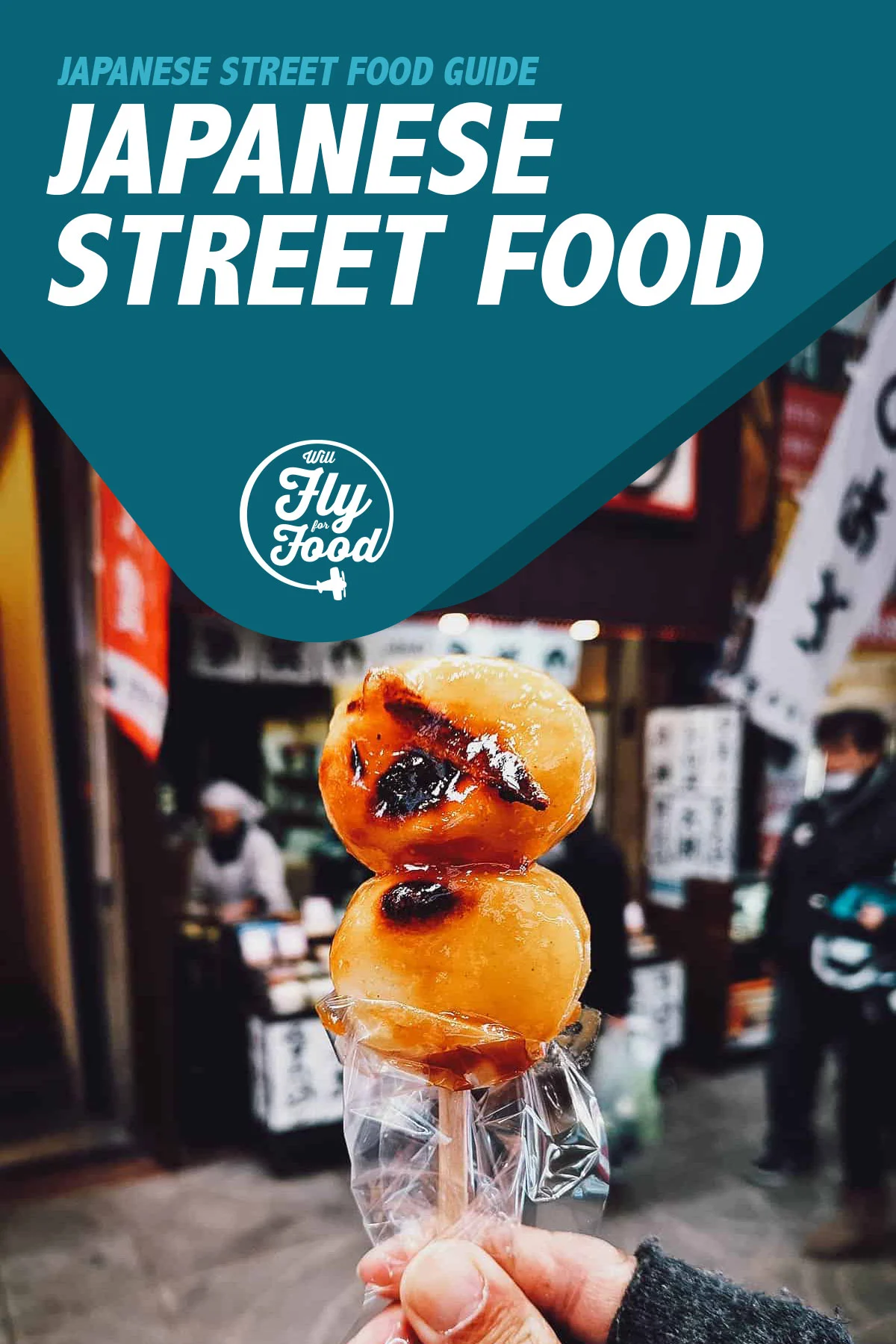
THE BEST JAPANESE STREET FOOD
WHAT IS JAPANESE STREET FOOD?
Like any cultural street food, Japanese street food pertains to Japanese dishes that are commonly eaten on the street. They’re typically sold from outdoor stalls or carts that offer no formal restaurant seating.
When doing research for this guide, I came across a few articles listing what seemed to me like questionable “Japanese street food dishes”. By that, I mean they don’t seem to fit the definition of classic street food. Some of those dishes include ramen, okonomiyaki, and gyoza.
While it is true that ramen is a common dish at yatai stalls in Fukuoka, it’s much more often enjoyed at ramen shops. The same goes for gyoza. The latter seems like an ideal street food dish but the sauce served with it makes it more difficult to eat on the street.
We’ve been to Osaka many times and we’ve never had okonomiyaki as street food. Unlike takoyaki, it seems more difficult and less enjoyable to eat on the street. Our Japanese friend is from the Kansai region and he doesn’t consider okonomiyaki to be classic Japanese street food either.
STREET FOOD ETIQUETTE IN JAPAN
I think that Japanese etiquette is part of the reason why Japanese street food isn’t as popular. In Japan, it’s traditionally been considered rude to eat while walking. Many Japanese people frown upon it which is why you’ll often find signs at markets telling you to eat your food in front of the stall you bought it from.
Most foreigners are oblivious to this. Personally, we’ll eat the dishes in front of the stall we bought it from or at a designated dining area. If we buy food from a konbini (convenience store), then we’ll eat it inside the shop or at a public space like a park with benches.
With that said, I don’t think it’s a major faux pas to eat while walking on Japanese streets. Our Japanese friend does it from time to time and it may even be gaining social acceptance. In some parts of Japan like Nakamise Shopping Street and Ameyoko Market in Tokyo, it’s acceptable to do tabe-aruki which means “eating while strolling”.
Just know that some places may not like it so if you see any signs telling you to not eat and walk, then it’s best to stand, eat, and go on your way only after you’ve finished eating.
15 MUST-TRY JAPANESE STREET FOOD DISHES
1. Takoyaki
The two dishes that are most representative of Osaka food culture are takoyaki and okonomiyaki. Both are frequently labeled as street food but in our opinion, only takoyaki should be considered true Japanese street food.
Takoyaki refers to a gooey ball-shaped snack made from wheat flour batter filled with chopped octopus, scraps of tempura, pickled ginger, and green onion. It’s usually topped with a sweet and savory takoyaki sauce along with Japanese mayo, green laver, and bonito flakes.
Like okonomiyaki, takoyaki stands are ubiquitous in Osaka. But unlike okonomiyaki, takoyaki is easy to eat and just as frequently enjoyed outside of the traditional restaurant setting.
RECIPE: Takoyaki
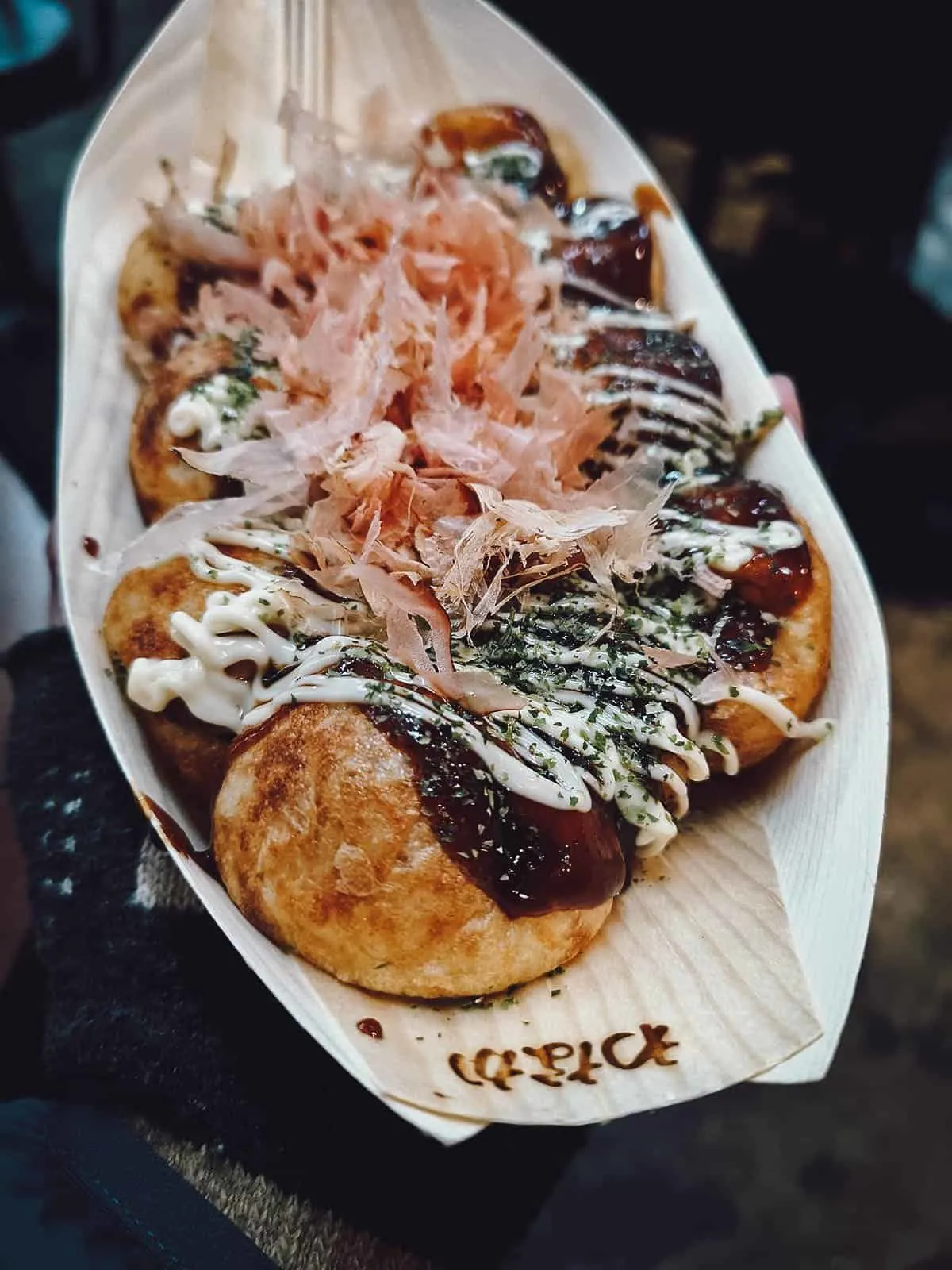
2. Tako Tamago
Tako tamago refers to these red glazed baby octopuses stuffed with a whole quail egg. Tako means “octopus” and “tamago” means egg.
Tako Tamago is skewered on bamboo sticks and is said to have been invented at Nishiki Market in Kyoto. They’ve since become a popular street food snack which you can enjoy at many markets throughout the Kansai region.
If you’re visiting Osaka, then you can find them at Kuromon Ichiba Market, one of the best places in Osaka to have street food.
RECIPE: Tako tamago
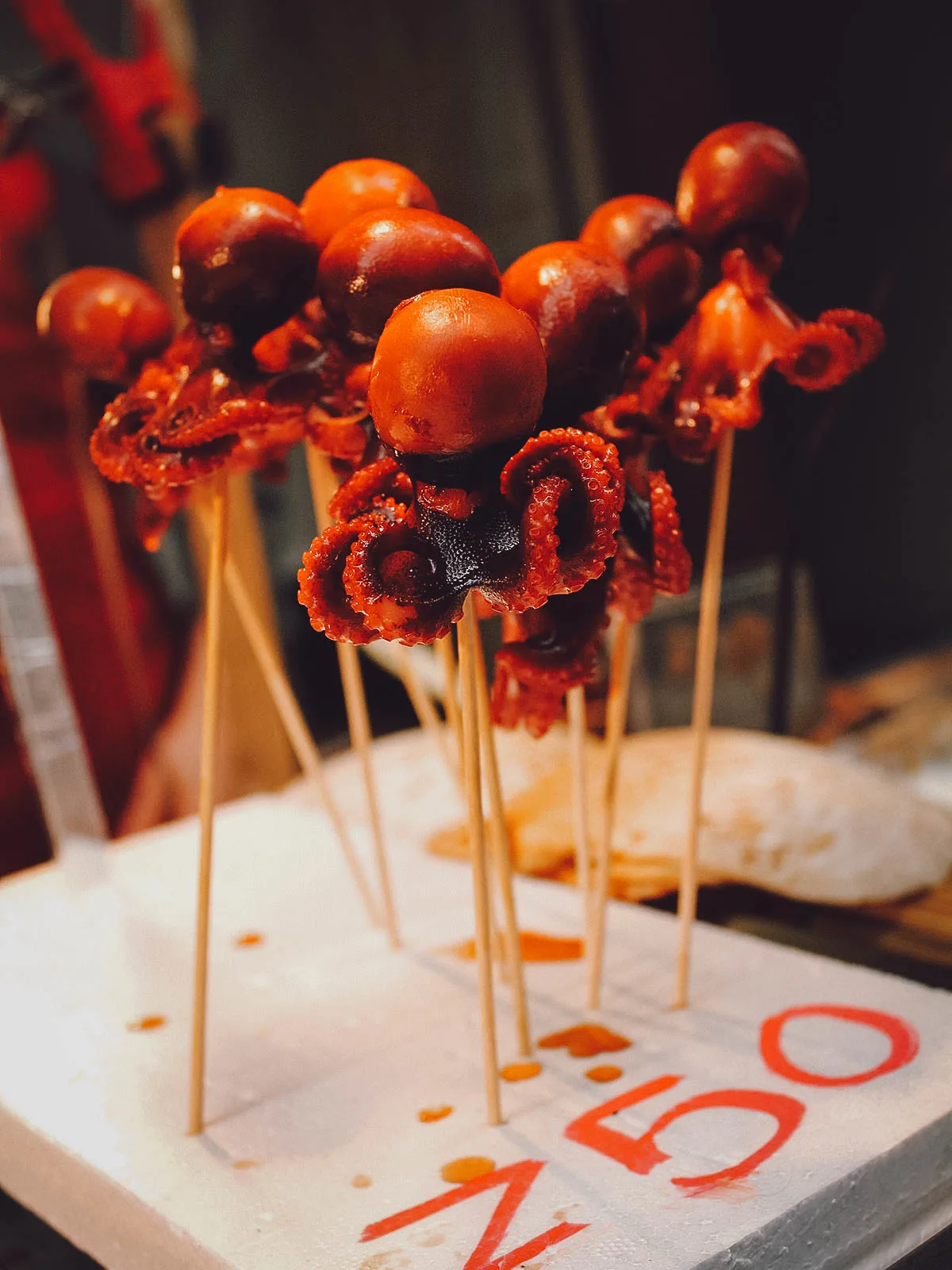
3. Kushiten
I asked my Japanese friend what he thought were the best Japanese street food dishes and kushiten was one of the first dishes he mentioned. It refers to a type of skewered Japanese fish cake.
Also referred to as tempura skewers, kushiten is made with surimi (white fish paste) that’s been pureed and then steamed, grilled, or deep-fried until firm. Kushi means “skewer” so the fish cakes are served on bamboo sticks to make them easy to eat.
According to my Japanese friend, kushiten is commonly served at festivals though similarly skewered izakaya favorites like kushikatsu and kushiyaki are not.
RECIPE: Japanese fish cakes
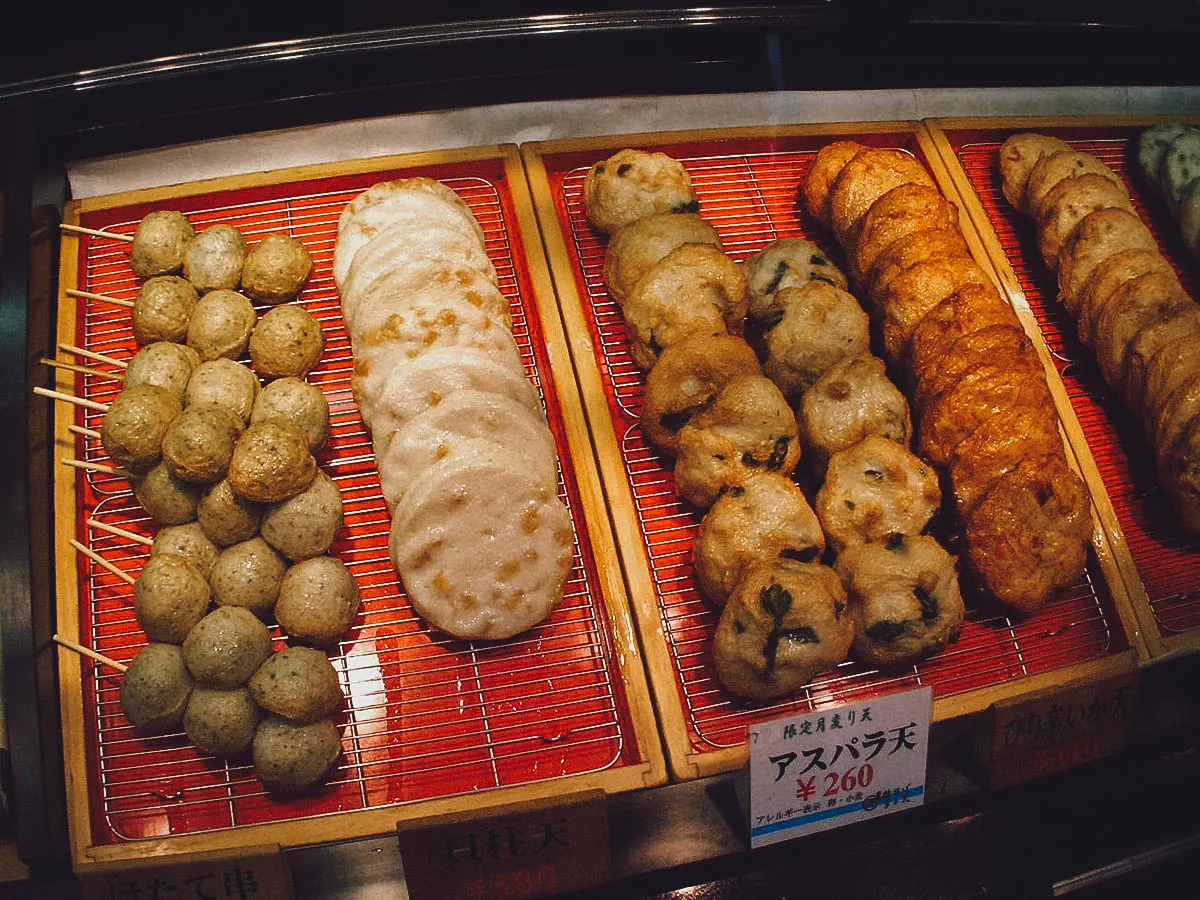
“松岡明芳“, CC BY-SA 3.0, via Wikimedia Commons / Processed in Photoshop and Lightroom
4. Dango
Dango refers to a street food snack consisting of skewered rice dumplings made from uruchi and glutinous rice flour. It has a chewy mochi-like consistency and can be covered in different coatings and glazes.
There are many different types of dango but one of the most popular is mitarashi dango. It’s covered in a sweet-savory glaze made with soy sauce, sugar, and starch. Other popular types of dango include hanami dango (three-colored dango), kinako dango (dusted with roasted soy flour), and anko dango (covered with red bean paste).
Depending on what it’s coated with, some types of dango are often enjoyed with green tea. They’re also popular as a dessert or snack, or as festival food.
Pictured below is miso dango from the popular Ohagi no Tambaya chain. As its name suggests, it’s covered in a delicious miso glaze.
RECIPE: Mitarashi dango
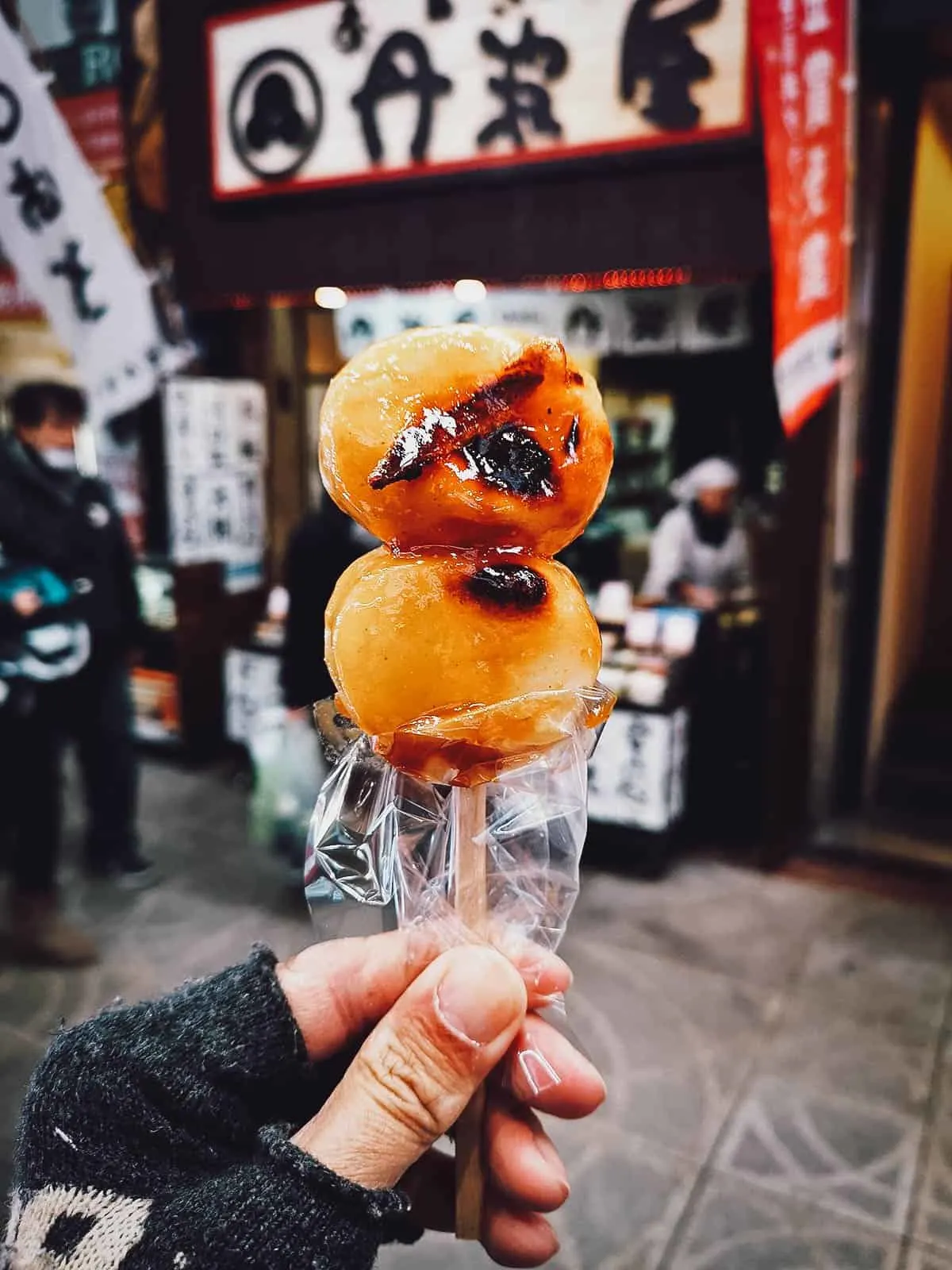
5. Korokke
Korokke is the Japanese word for croquette. It refers to breaded and deep-fried patties that were introduced to Japan by the French in the late 19th century.
To prepare, different types of chopped meat, seafood, or vegetables are mixed with mashed potatoes or a white sauce. They’re then rolled in wheat flour, eggs, and panko breadcrumbs before being deep-fried to a golden brown.
Korokke is an easy-to-eat street food snack that’s popular throughout Japan. You can even find them at groceries and konbinis.
RECIPE: Korokke
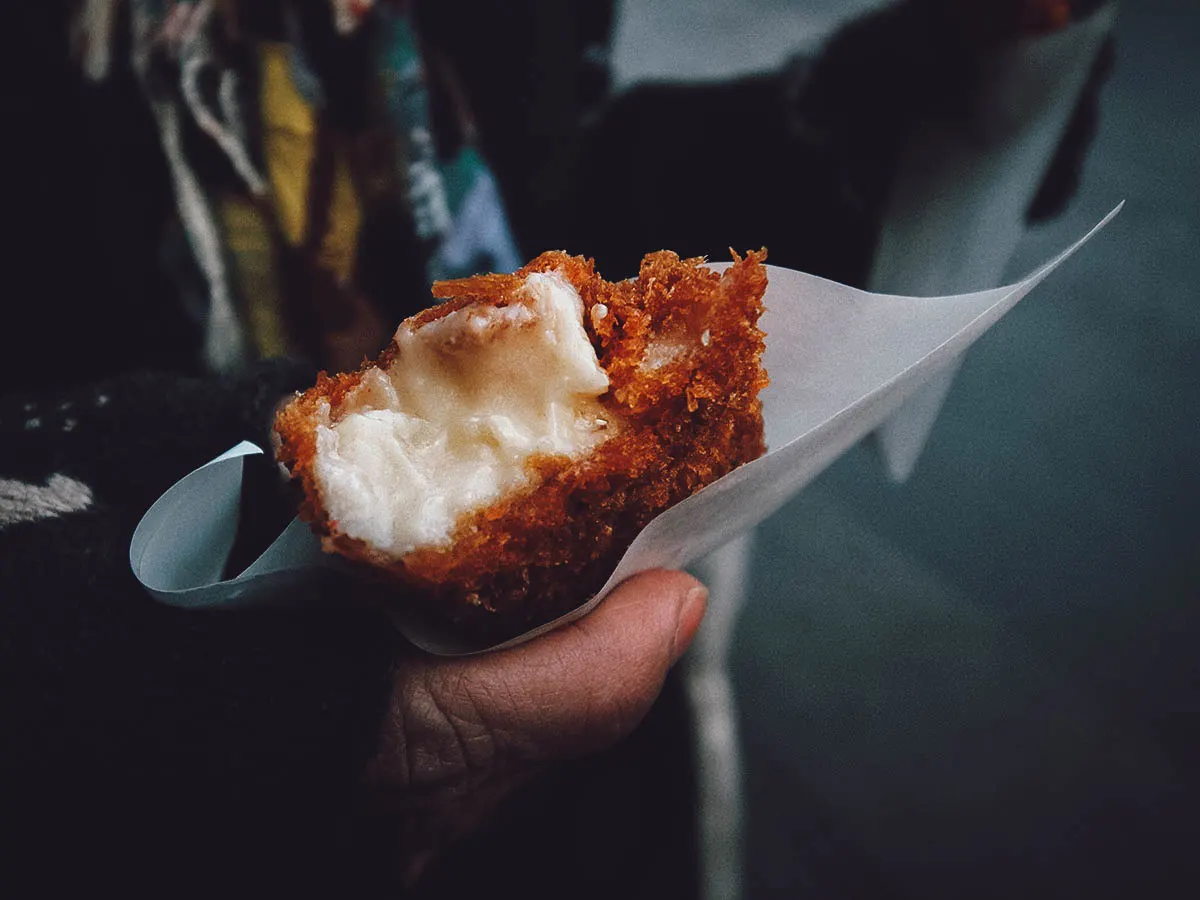
6. Senbei
Senbei refers to a type of Japanese rice cracker. They comes in a variety of shapes, sizes, and flavors and can be both savory or sweet.
Senbei is usually made with rice, wheat flour, or starch that’s either baked, deep-fried, or grilled over charcoal. They’re often brushed with a glaze made from mirin and soy sauce and can be flavored with other ingredients like nori, black sesame, red chili pepper, and seafood.
Senbei have a unique flavor and texture that’s unlike any cracker I’ve ever had. They’re crunchy, savory-sweet, a little sticky, and sometimes smokey in flavor.
RECIPE: Senbei
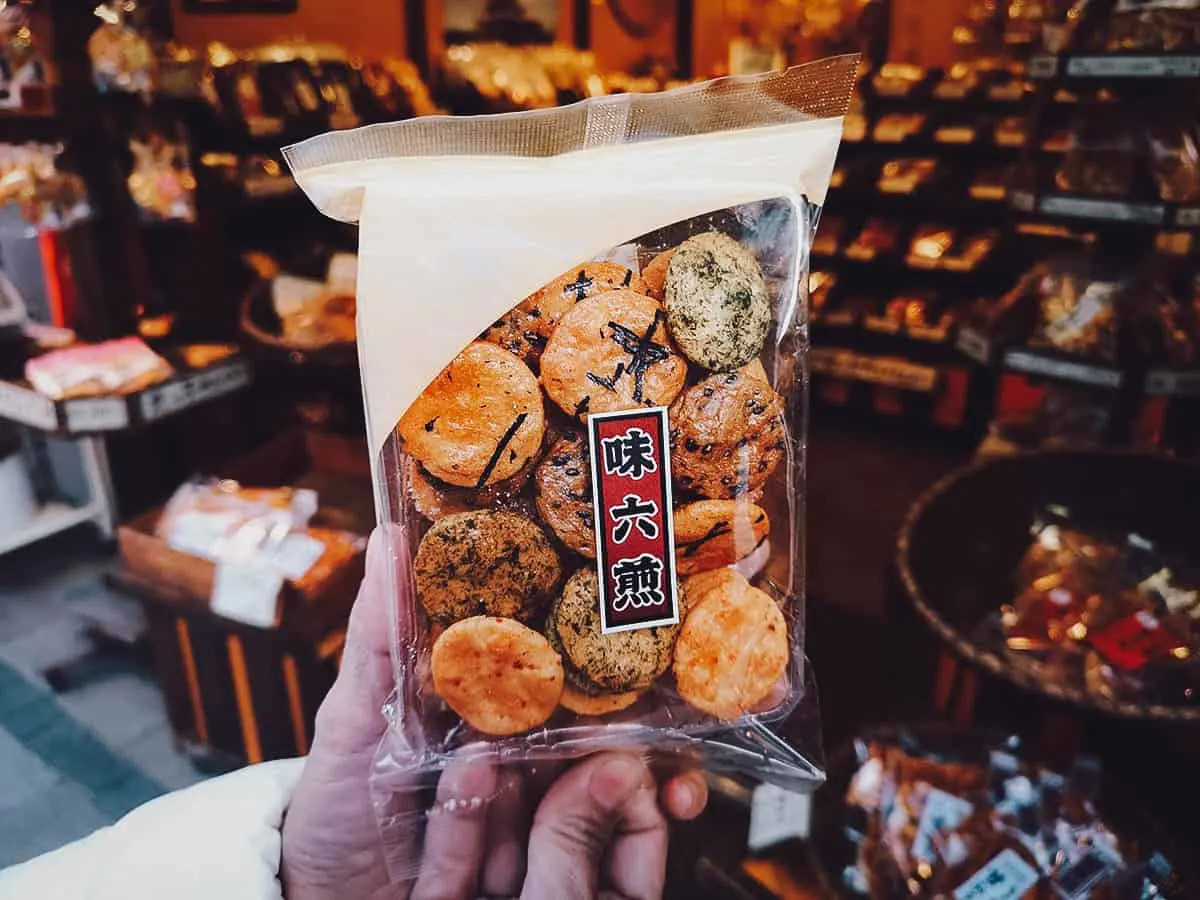
7. Onigiri
Onigiri is my go-to konbini snack. If I want something quick and easy to eat that won’t fill me up too much, then I’ll usually go with onigiri.
Onigiri refers to a popular Japanese snack made with white rice, nori, and some type of filling. They’re called rice balls though they often come in triangular and cylindrical shapes as well.
Typical onigiri fillings include tuna, salmon, umeboshi (pickled Japanese plum), katsuobushi (bonito flakes), mentaiko (pollock roe), and kombu (kelp), though they can be filled with any salty or sour ingredient that can be used as a natural preservative.
In spite of its name and its appearance, onigiri isn’t a form of sushi. Sushi is made with vinegared rice while onigiri is made with unseasoned white rice.
RECIPE: Onigiri
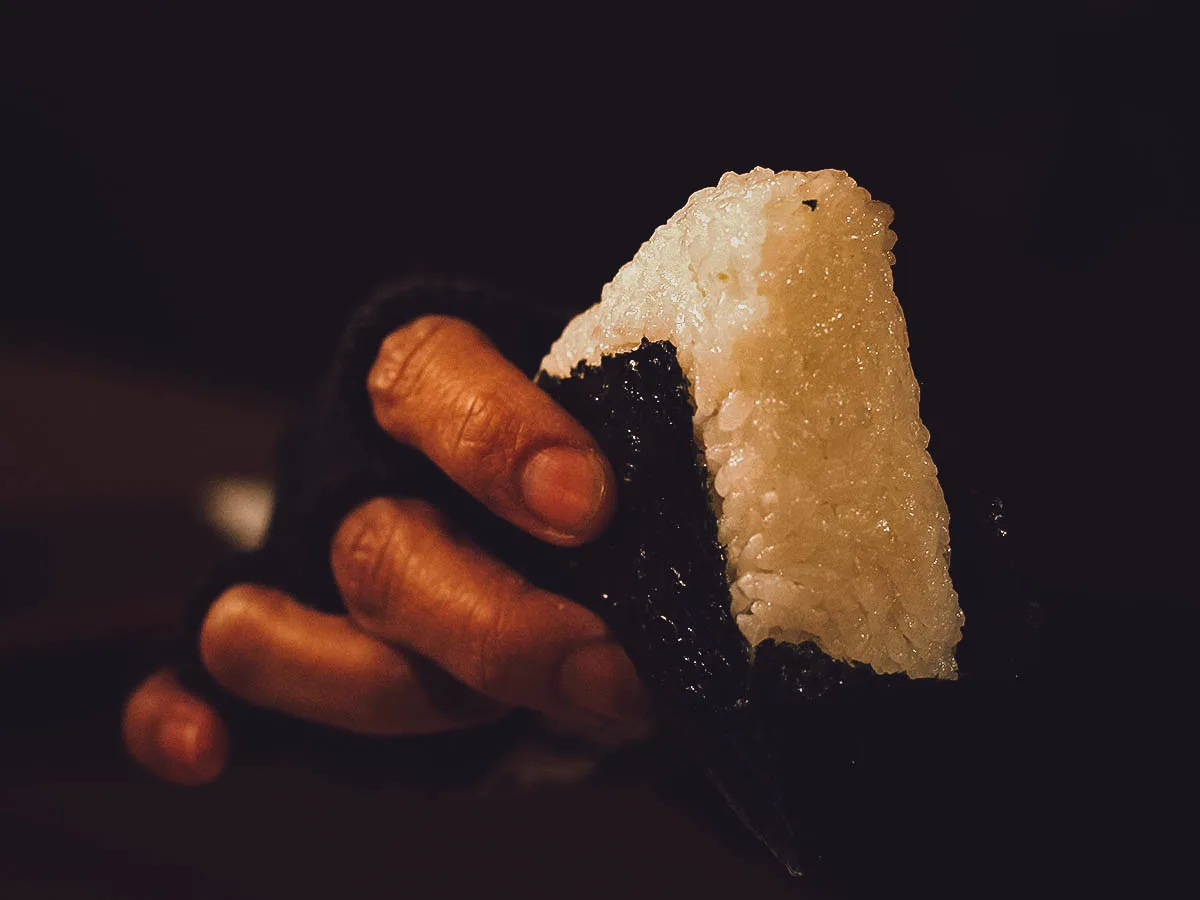
8. Yakisoba
Yakisoba means “fried noodles” and refers to a Japanese stir-fried noodle dish. In spite of the “soba” in its name, it isn’t made with buckwheat noodles. It’s made with wheat flour noodles flavored with a condiment similar to worcestershire sauce.
Yakisoba is prepared by frying ramen-style wheat noodles with pork, cabbage, and onions on a griddle then topping it with benishoga (pickled ginger), katsuobushi, aonori (seaweed powder), Japanese mayonnaise, and yakisoba sauce. Occasionally, a fried egg is added on top.
Yakisoba is quick to prepare and easy to eat. It’s one of the most popular street food dishes served at Japanese festivals.
RECIPE: Yakisoba
9. Yaki Tomorokoshi
Yaki tomorokoshi refers to charcoal grilled cobs of corn brushed with a glaze made from soy sauce, mirin, and butter. Like yakisoba, it’s a popular festival food in Japan, especially during summer festivals when corn is in season.
RECIPE: Yaki tomorokoshi
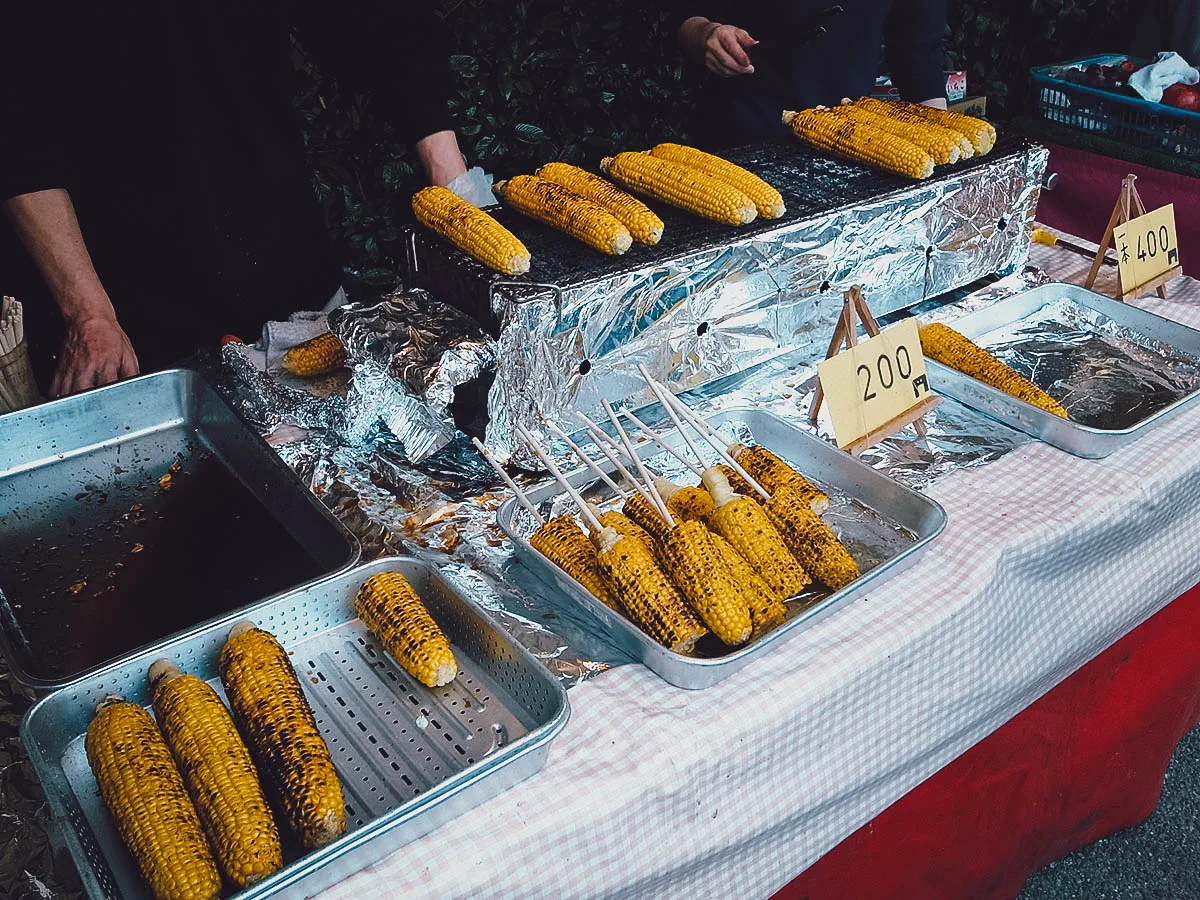
“Food stand; Grilled corn” by Lisa Pinehill, used under CC BY-SA 2.0 / Processed in Photoshop and Lightroom
10. Yaki Imo
Yaki imo refers to a traditional Japanese street food dish made with roasted sweet potatoes. A type of Japanese sweet potato called satsuma-imo is roasted or baked over charcoal and served in paper packets to be enjoyed as a snack.
Yaki imo is commonly made with satsuma potatoes though they can be made with annou, milk sweet, and beni haruka potatoes as well. Washed potatoes are thrown over coals without being seasoned or buttered to allow the natural flavors of the potato to shine through.
When cooked right, yaki imo has a pleasantly chewy skin with soft and tender flesh that’s sweet and caramel-like in flavor, much like a Thanksgiving yam.
RECIPE: Yaki imo
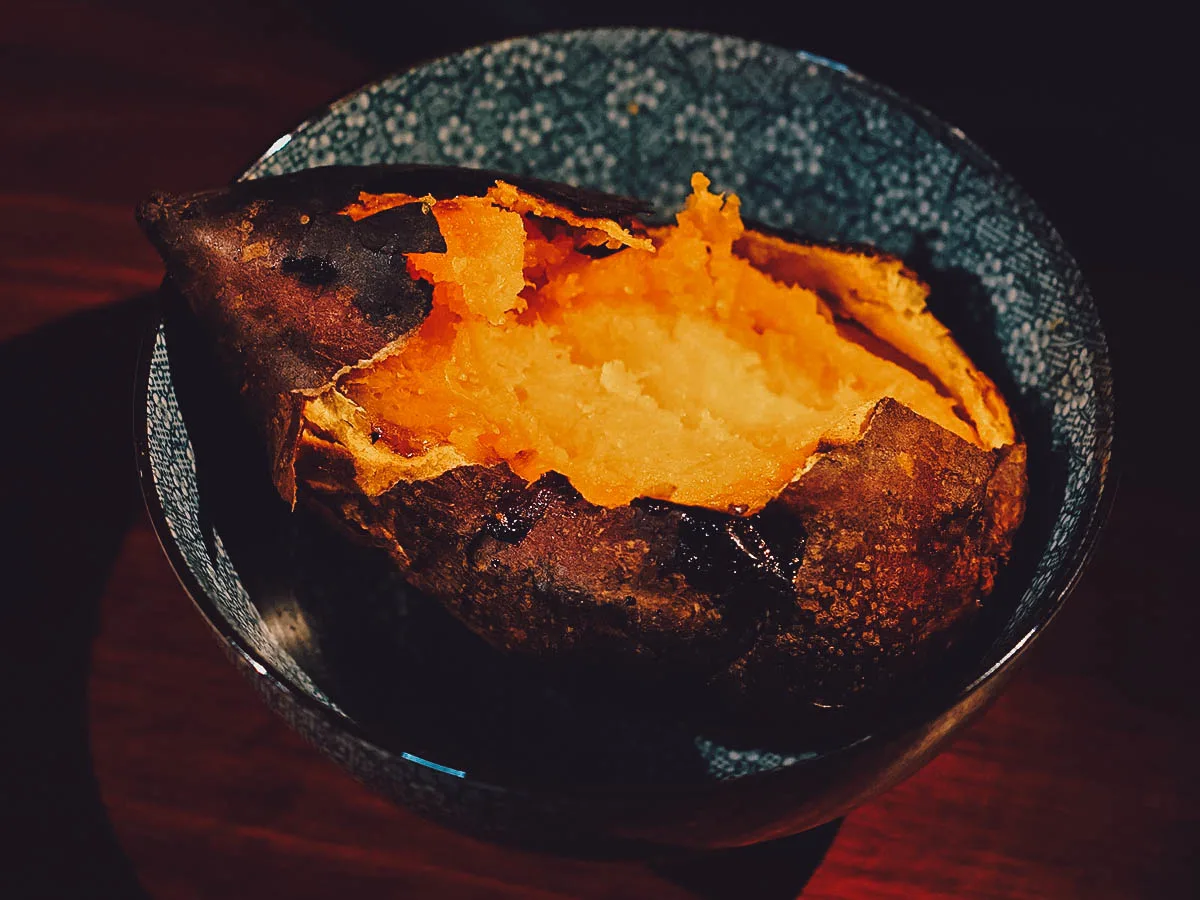
Silentpilot, CC0, via Wikimedia Commons
Yaki imo is a popular street food snack in autumn and winter. You can typically find them being sold from these street food carts and trucks by the side of the road, usually around train stations.
11. Imagawayaki
If you’re familiar with Taiwanese food, then you may recognize these bean-filled pastries as Taiwanese wheel cakes or red bean cakes. They’re originally from Japan where they’re known as imagawayaki.
Imagawayaki are pancake-like desserts cooked in disk-shaped cast-iron molds. They’re cooked till crispy and traditionally filled with a sweet azuki bean paste, though more modern versions can be filled with a variety of ingredients like vanilla custard, fruit custard, chocolate and matcha. They can even be filled with savory ingredients like curry, potato, and cheese.
Imagawayaki are a popular festival food in Japan though they can be purchased from shops as well. According to my Japanese friend, the Gozasoro chain makes the best imagawayaki in Japan.
They’re known as imagawayaki in the Kanto region (Tokyo) though they’re often referred to by different names depending on the region. In the Kansai region (Osaka/Kyoto/Nara), they’re known as kaitenyaki or obanyaki.
RECIPE: Imagawayaki
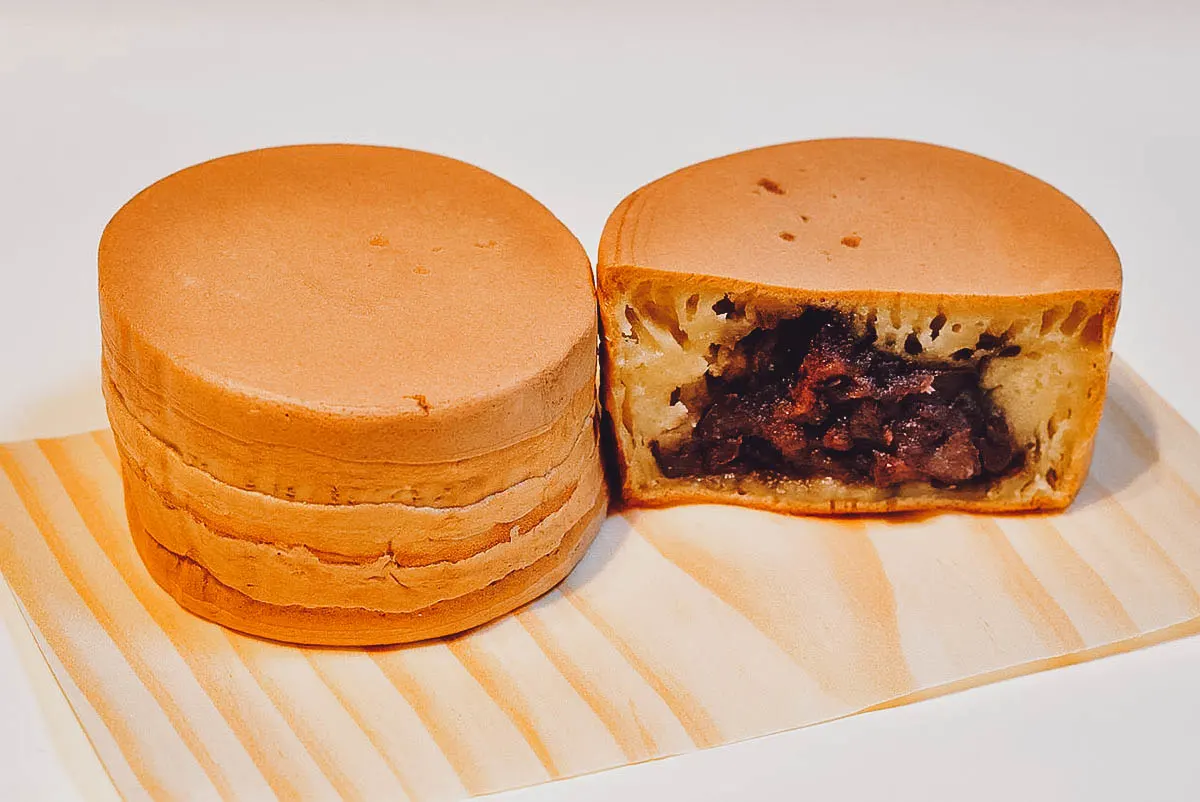
Ocdp, CC0, via Wikimedia Commons
12. Taiyaki
Like imagawayaki, taiyaki are pancake-like snacks filled with sweet azuki bean paste. They’re made in a fish-shaped mold resembling tai (red seabream), hence the name taiyaki.
Taiyaki is commonly filled with sweetened azuki beans though they can be made with other fillings as well like custard, chocolate, cheese, and sweet potato. It’s basically a fish-shaped version of imagawayaki, but with a different texture.
Taiyaki is one of the most popular Japanese street food snacks. Tai is considered a symbol of good luck so you can find taiyaki pretty much anywhere in Japan.
RECIPE: Taiyaki
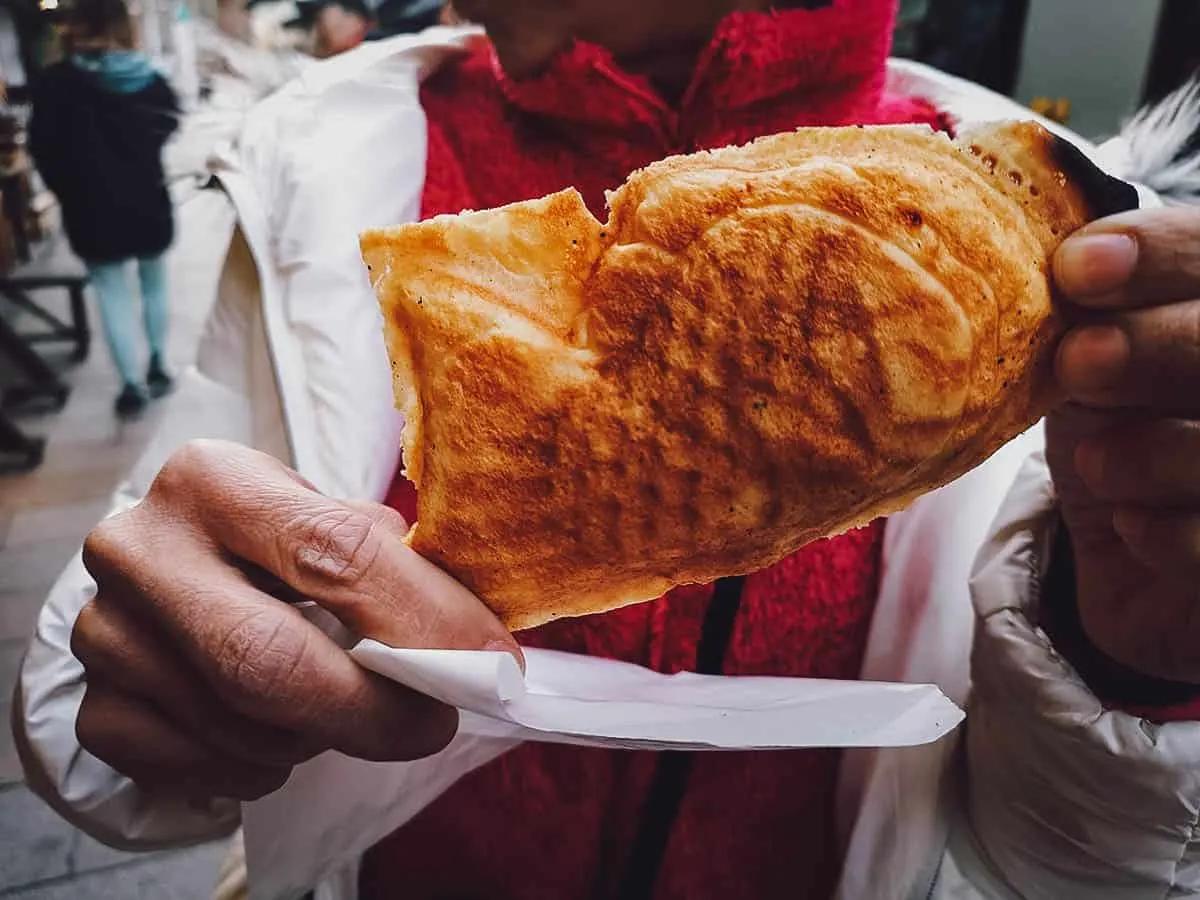
13. Kashi Pan / Kare Pan
Kashi pan refers to Japanese sweet breads filled or topped with a variety of ingredients like sweetened azuki bean, jam, chocolate, or custard. Kare pan is similar except its breaded and deep-fried and filled with savory ingredients like Japanese curry.
You’ll find many different types of kashi pan and kare pan at konbinis. When we’re in Japan, it’s part of our nightly ritual to stop at convenience stores to buy kashi pan before retiring to our hotel. We eat a few for dessert and save the rest for breakfast the following morning.
RECIPE: Melon pan
I don’t think this really qualifies as kashi pan or kare pan but I just wanted to share with you this odd-looking snack called yakisoba pan. As its name suggests, it’s basically yakisoba served in a hot dog bun.
The Japanese love these and you can find them at any convenience store throughout Japan.
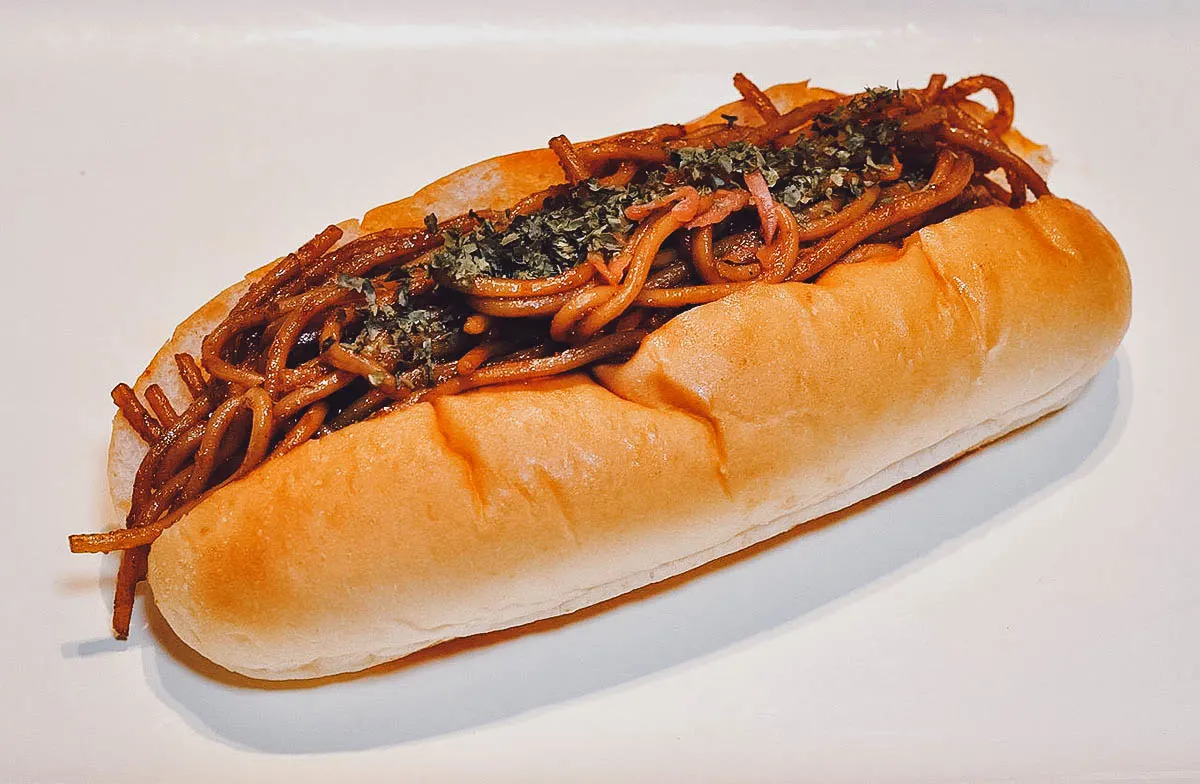
Ocdp, CC0, via Wikimedia Commons
14. Shu Cream
Shu cream is the Japanese term for a cream puff. It refers to French-inspired choux pastry puffs filled with sweet custard and dusted with powdered sugar.
The most popular type of shu cream is filled with custard cream but they can be filled with other ingredients as well like chocolate, matcha, coffee, or strawberry cream.
Common at metro stations, the Beard Papa chain is one of the most popular places to try shu cream in Japan.
RECIPE: Shu cream
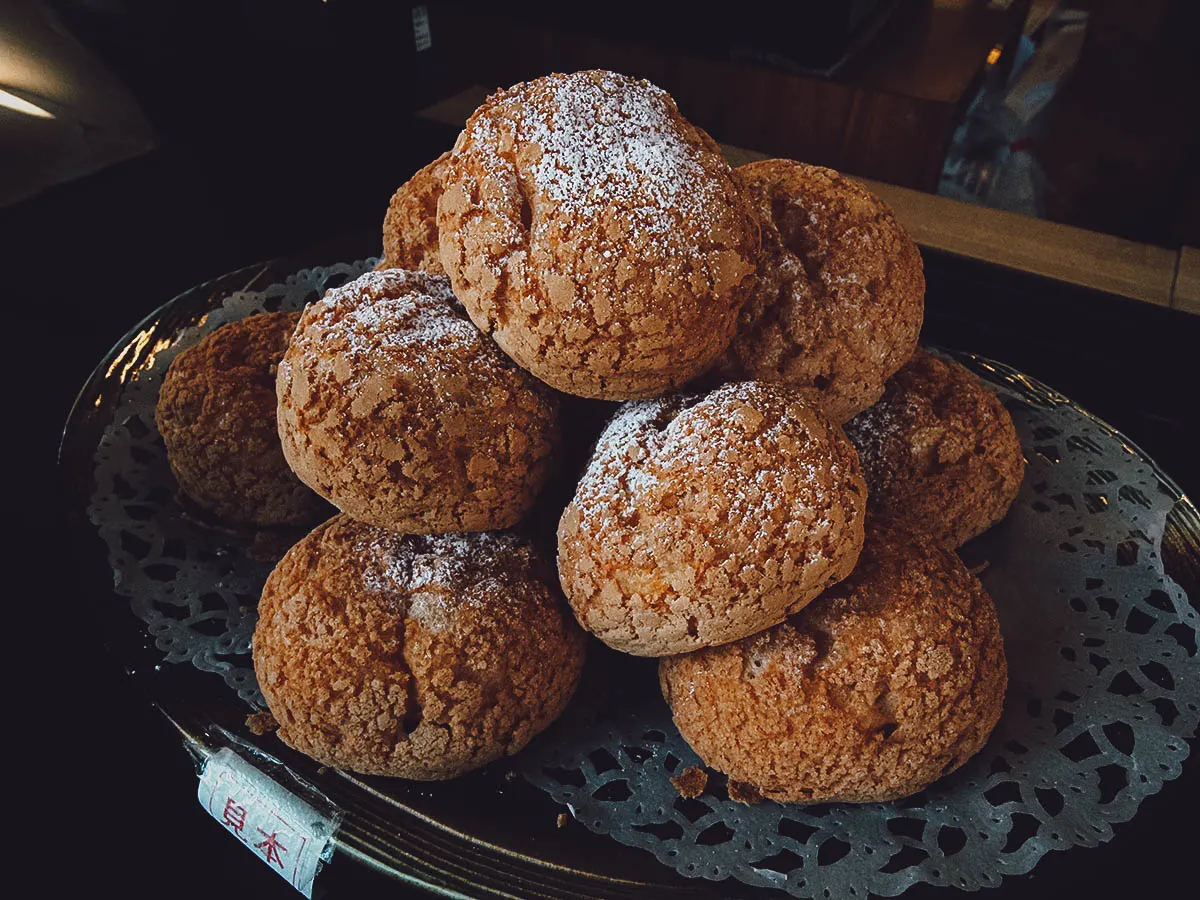
15. Soft Cream
Soft cream is what the Japanese call soft serve ice cream. It’s creamier and thicker than your average soft serve and is perhaps the single most popular street food snack on this list. It’s available everywhere in Japan, from rest stops to markets to festivals and convenience stores.
Japan, especially Hokkaido, is known for its dairy industry which is why Japanese soft cream is so good. It’s delicious everywhere in Japan but especially in Hokkaido. No trip to Sapporo can ever be complete without indulging in soft cream and other Hokkaido milk products.
Pictured below is the terrific Uji matcha soft cream I enjoyed at Kyoto’s Nishiki Market.
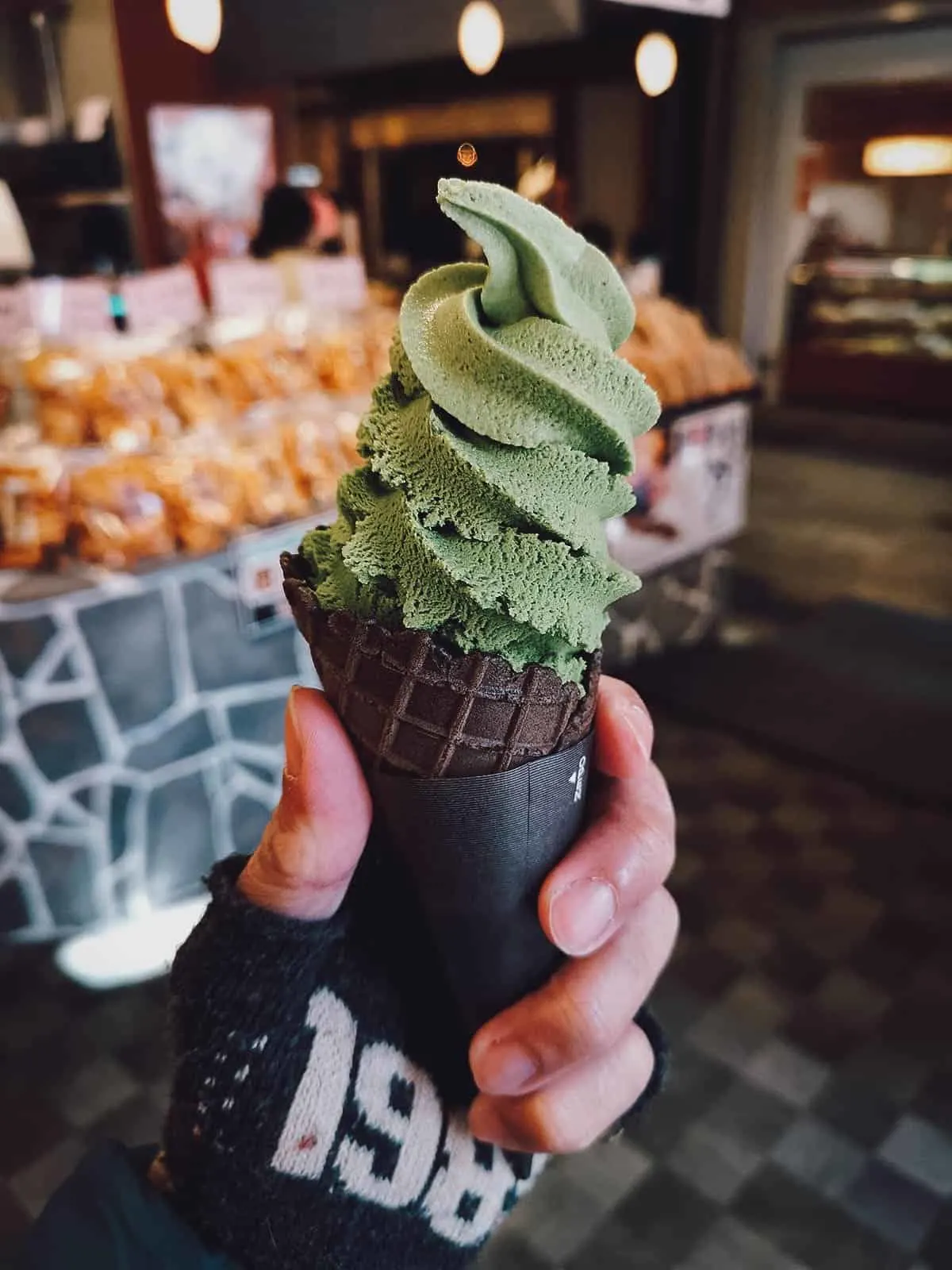
Is this the most decadent cone of soft serve you’ve sever seen? This gold leaf soft cream was from the Hakuichi shop in Kanazawa, a city known for producing 99% of Japan’s high-quality gold leaf. Talk about boujee!
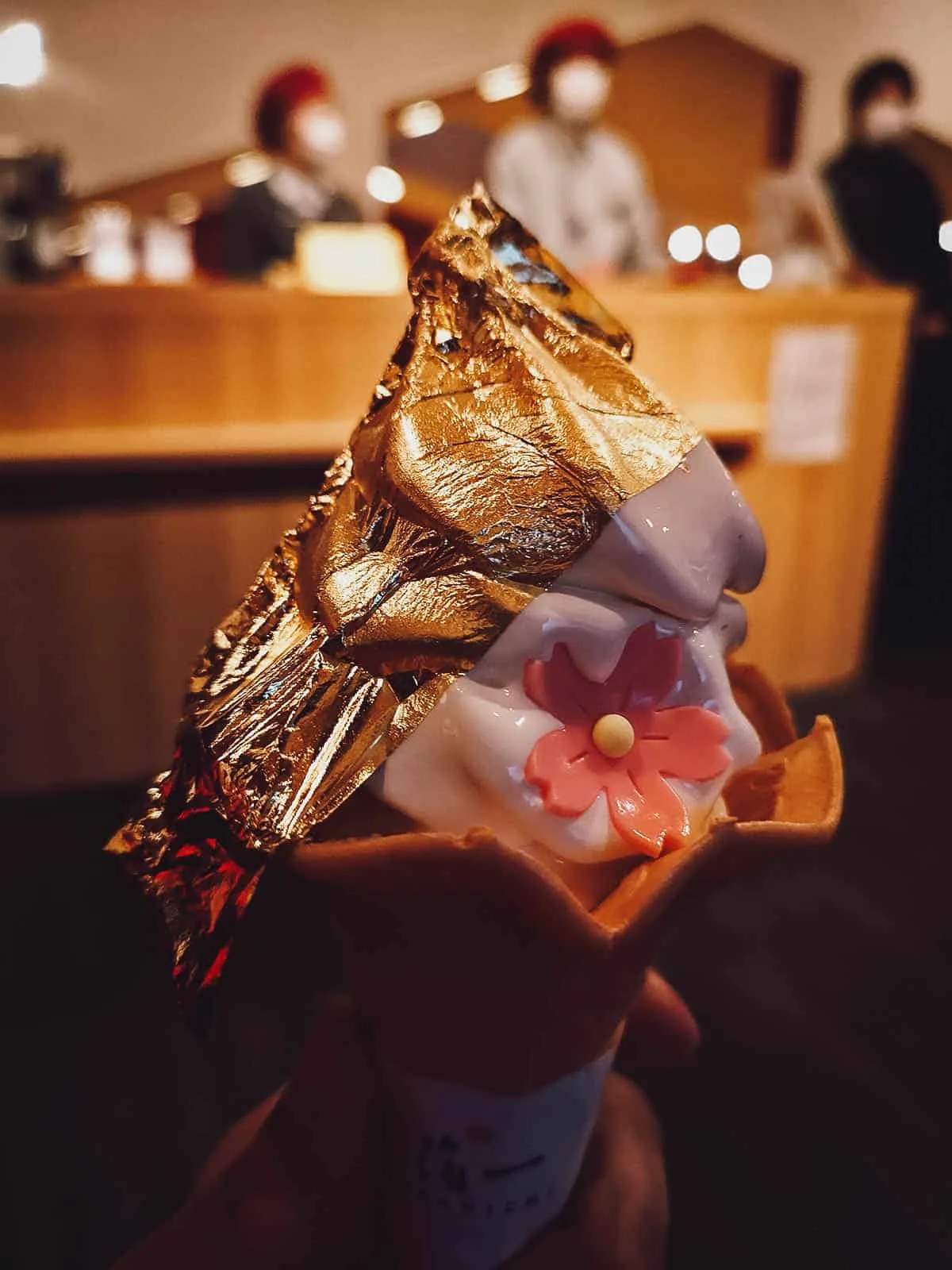
POPULAR PLACES FOR STREET FOOD IN JAPAN
Street food is available throughout the country but listed below are some of the most popular places for tourists to enjoy street food in Japan.
1. Yatai Stalls in Fukuoka
When I think of Japanese street food, Fukuoka’s yatai stalls is the first image that comes to mind. They’re basically Japan’s version of the street food stall.
Yatai stalls are small outdoor stalls that can seat about 8-10 people. They open only at night and serve a range of small izakaya-type dishes like yakitori, kushiyaki, grilled seafood, and Hakata ramen. Enjoying beers and bar chow while rubbing elbows with locals is one of the best things you can do in Fukuoka.
Yatai stalls can be found in other Japanese cities but they’ve become largely associated with Fukuoka. They’re an iconic symbol of Fukuoka food culture and one of the best places to have a true street food experience in Japan.
At present, there are about 150 yatai stalls in Fukuoka. They’re clustered in different pockets of the city like Nagahama, Tenjin, and Nakasu.
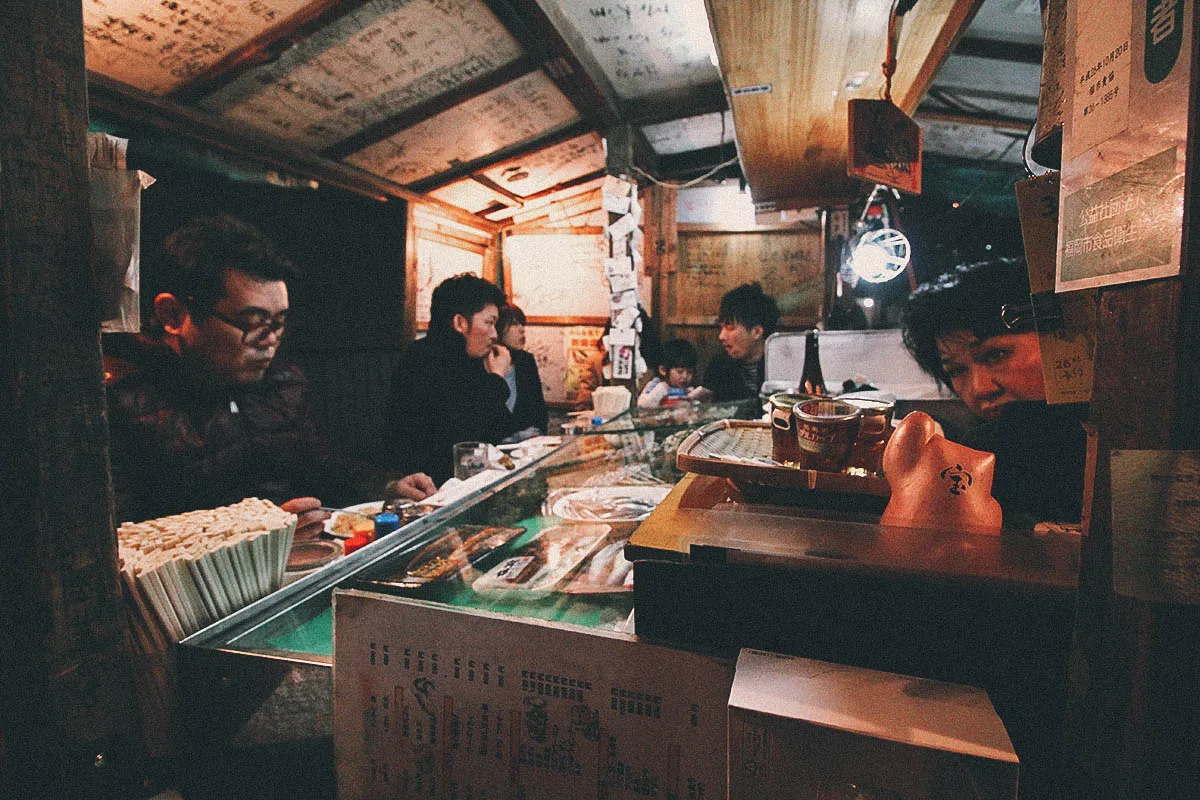
2. Dotonbori in Osaka
No first-time Osaka itinerary can be complete without allocating a good chunk of your time to the Shinsaibashi and Dotonbori areas. While Shinsaibashi is recognized for being one of the city’s premier shopping districts, Dotonbori is known for its food.
Aside from its dizzying plethora of restaurants, bars, and cafes, you’ll find many of these eye-catching street food stands selling dishes like takoyaki, gyoza, Japanese pastries, and soft cream.
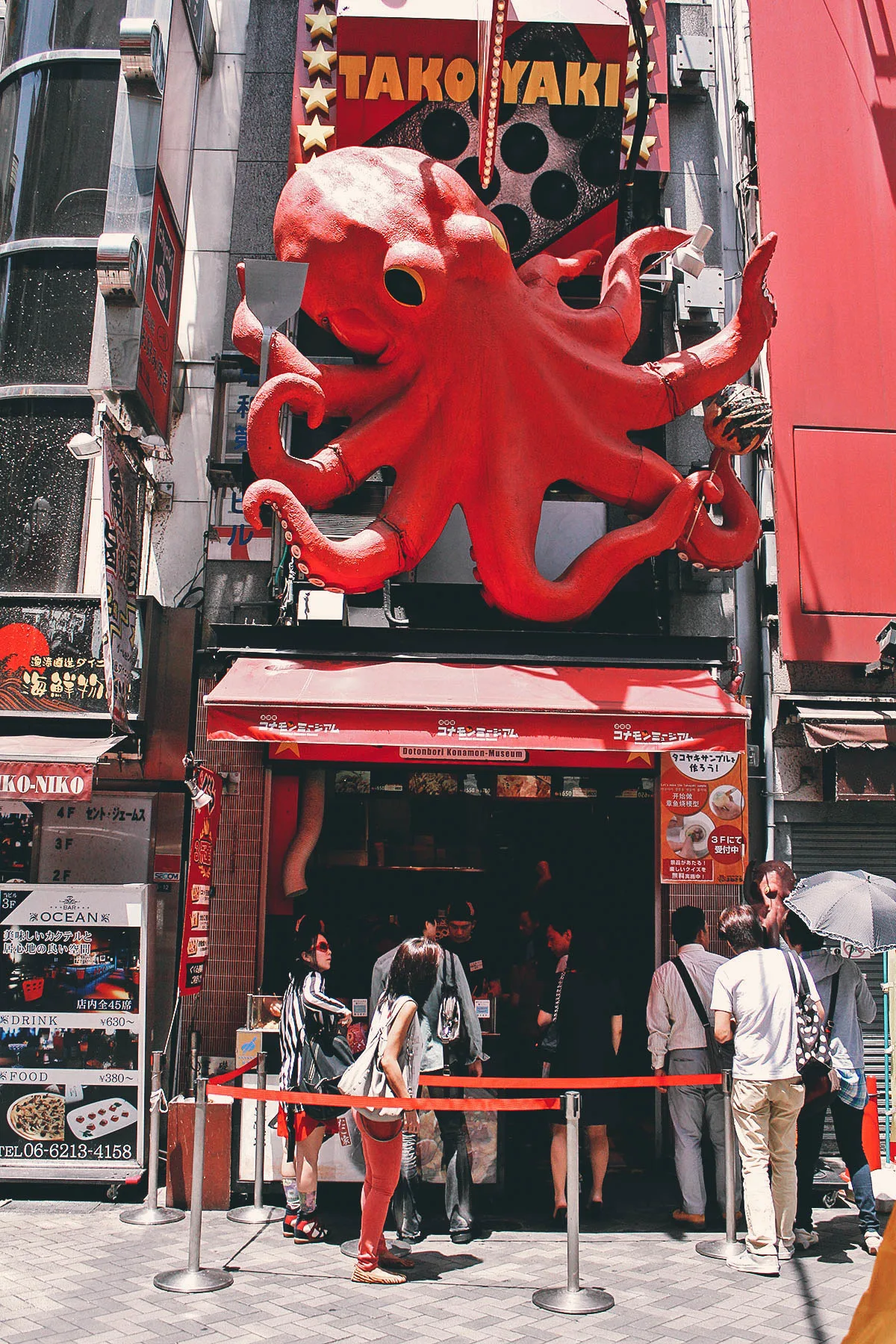
3. Kuromon Ichiba Market in Osaka
About a 10-minute walk from the Dotonbori area is Kuromon Ichiba Market, one of the best places to have street food in Osaka. Open since 1902, this market contains about 150 shops selling fresh fish, seafood, meat, fruits, and vegetables. It’s where many of the city’s chefs get their supplies, hence its nickname “Osaka’s kitchen”.
Aside from fresh produce, you’ll find many restaurants and stalls offering a variety of street food dishes at Kuromon Ichiba Market. Things like uni, sushi, grilled seafood, takoyaki, tako tamago, and wagyu are all part of the menu here.
Kuromon Ichiba Market is one of our favorite stops in Osaka and a place we always visit on every return trip to the city. You can easily visit on your own but if you’d like to go with a guide, then you may be interested in booking a tour (byFood | Magical Trip).
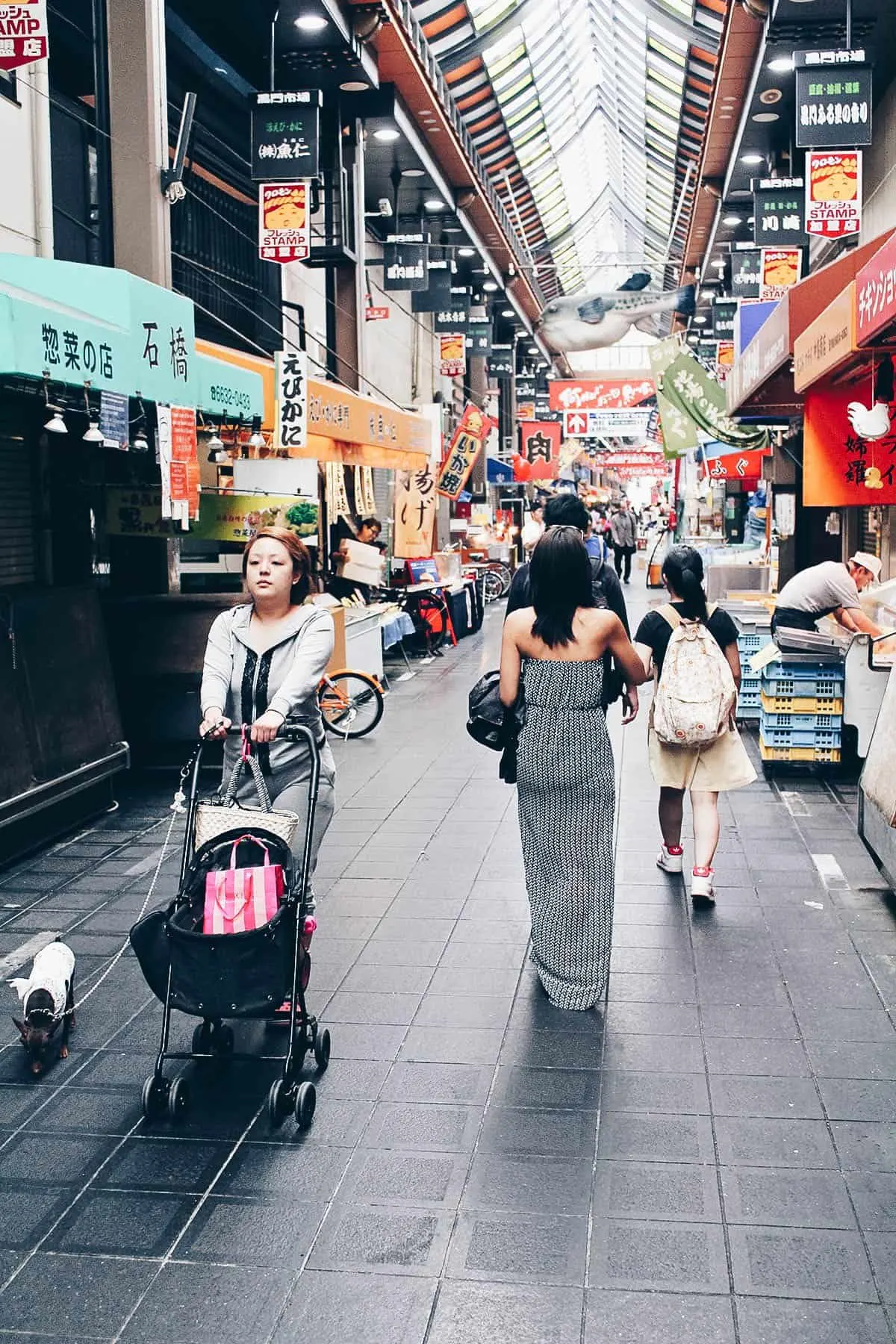
4. Nishiki Market in Kyoto
Nishi Market is like the Kyoto equivalent of Osaka’s Kuromon Ichiba Market. It’s nicknamed “Kyoto’s kitchen” and features over a hundred shops, street food stalls, and small restaurants offering a wide range of local food products.
Kyoto is known for its many interesting regional food specialties. If you’d like to experience as many of them as you can under one roof, then Nishiki Market is one of the best places for you to go.
Nishiki Market is easy to visit on your own, but if you’d like to have a guide take you to the best spots, then you may be interested in booking a tour (byFood | Magical Trip).
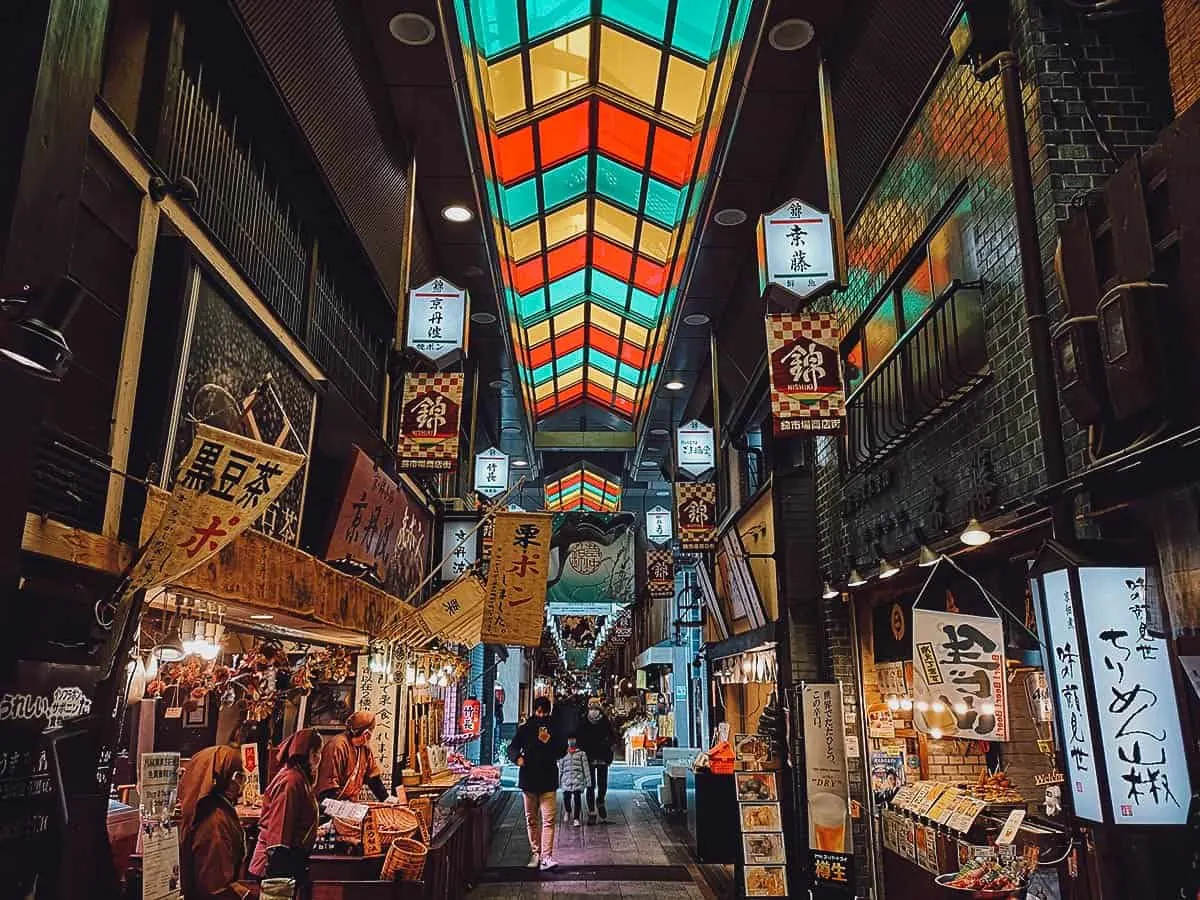
5. Tsukiji Outer Market in Tokyo
For me, Tokyo’s famed Tsukiji Outer Market isn’t just one of the best places to have street food in Tokyo, it’s one of the best places to have street food in Japan period.
You may recognize Tsukiji Market as the former home of Japan’s most famous tuna auction. The auction has since moved to Toyosu Market but Tsukiji’s outer market is still open to the public and thriving. It’s filled with hundreds of restaurants and stalls offering a dizzying array of seafood and street food.
If you love seafood, then you need to add Tsukiji Outer Market to your Tokyo itinerary. It’s easy enough to explore on your own but if you’d like to go with a guide, then there are plenty of walking food tours to choose from: Klook | Get Your Guide | byFood | Magical Trip (Option 1 | Option 2).
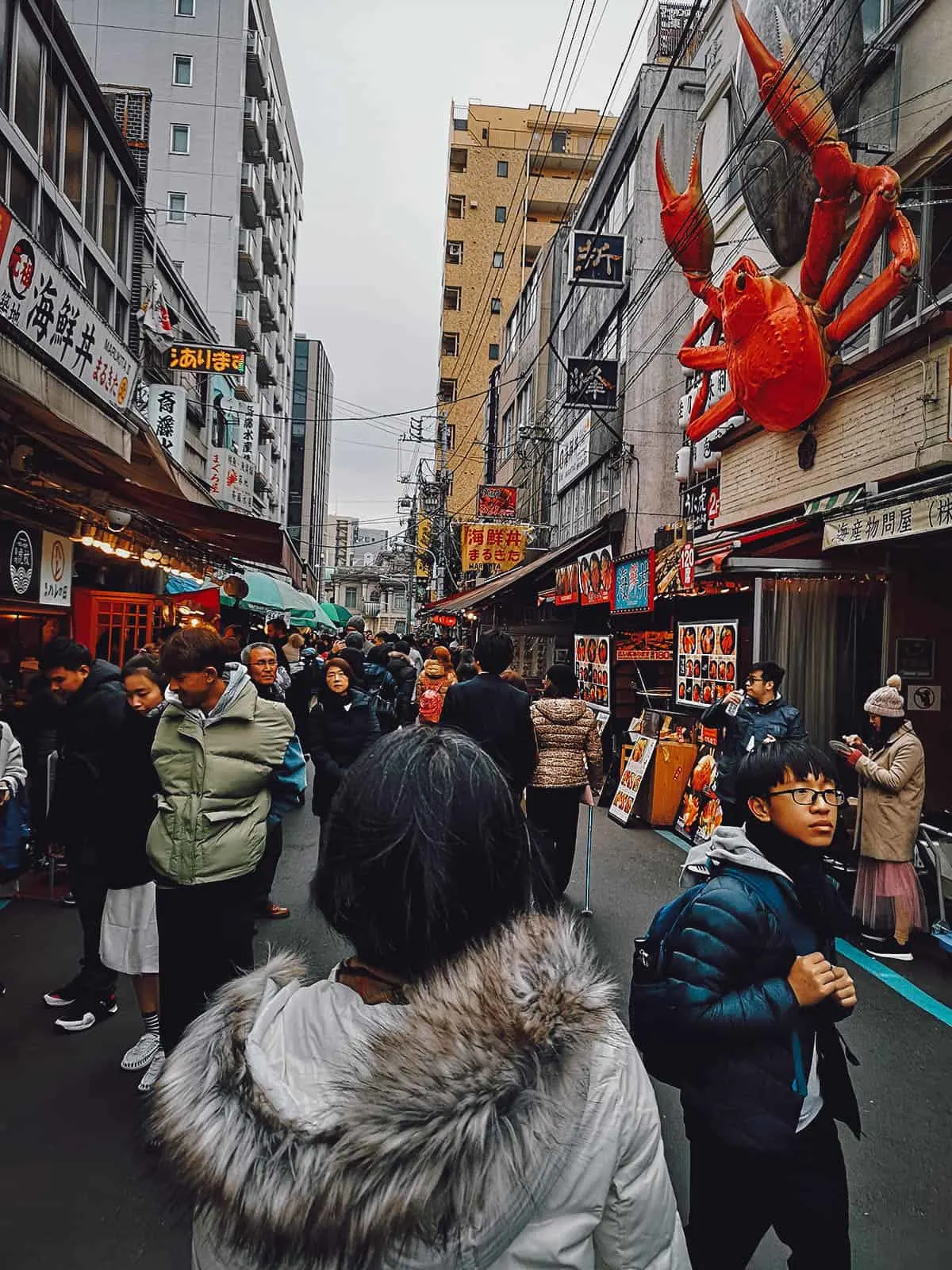
6. Nakamise Shopping Street in Tokyo
Nakamise Shopping Street is another great place to have street food in Tokyo. It refers to the area between Asakusa’s Senso-ji Temple and its main gate, Kaminarimon. Senso-ji is one of Tokyo’s most visited cultural attractions so if it’s your first time in the city, then you’ll probably be making a stop here.
Nakamise Shopping Street is a 250-meter approach filled with many small shops selling souvenir items and Tokyo street foods like kinako dango, senbei, and traditional Japanese candies. It’s a fun atmosphere and a great place to munch on street food while enjoying a bit of culture in Tokyo.
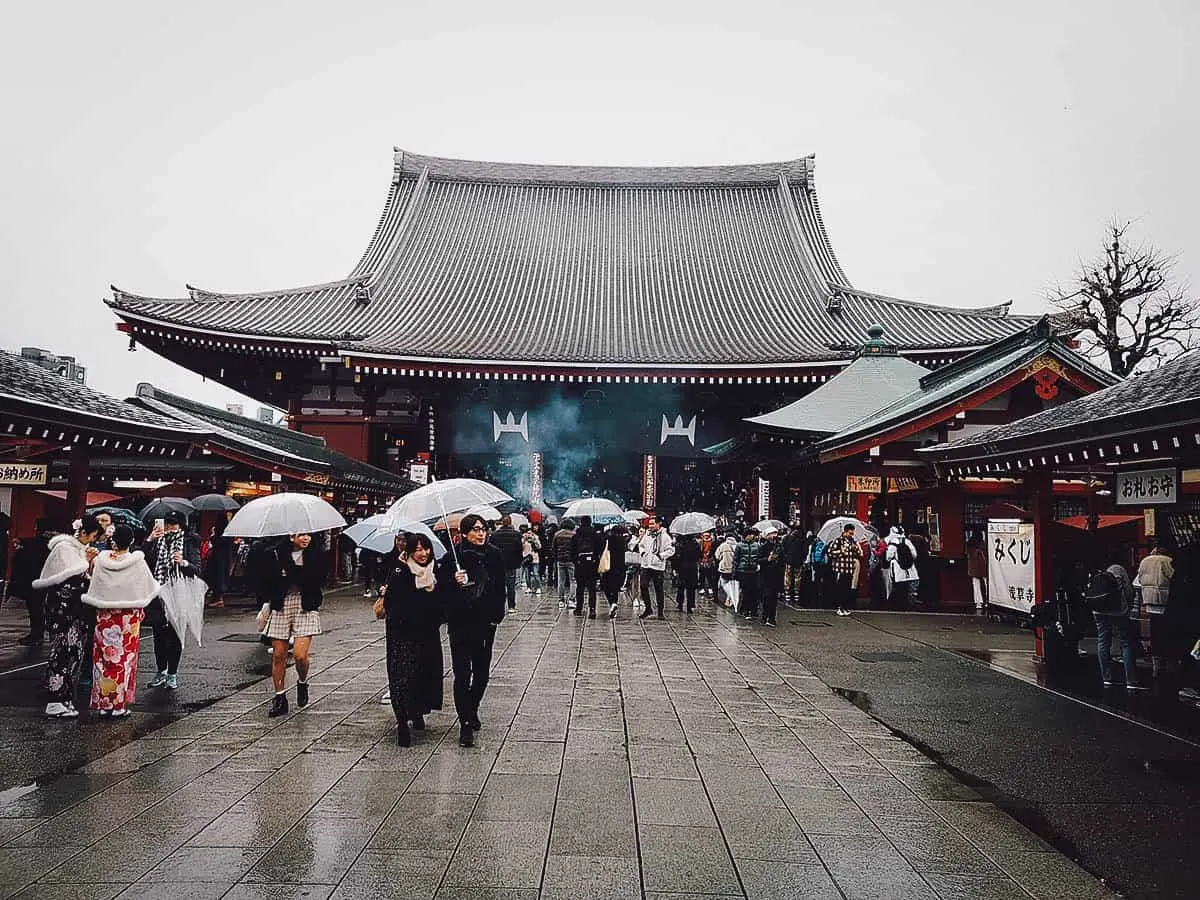
7. Ameyoko Market in Tokyo
Ameyoko Market in the Ueno District is another great place to have street food in Tokyo. It refers to a popular open-air market that runs parallel to the Yamanote Line between Ueno and Okachimachi stations.
You’ll find hundreds of shops at Ameyoko Market selling different types of products ranging from fresh seafood to clothing to candy. I had one of my cheapest meals in Tokyo there – a JPY 550 kaisendon bowl at the Minatoya seafood stall. You can check out our Tokyo food guide for more information.
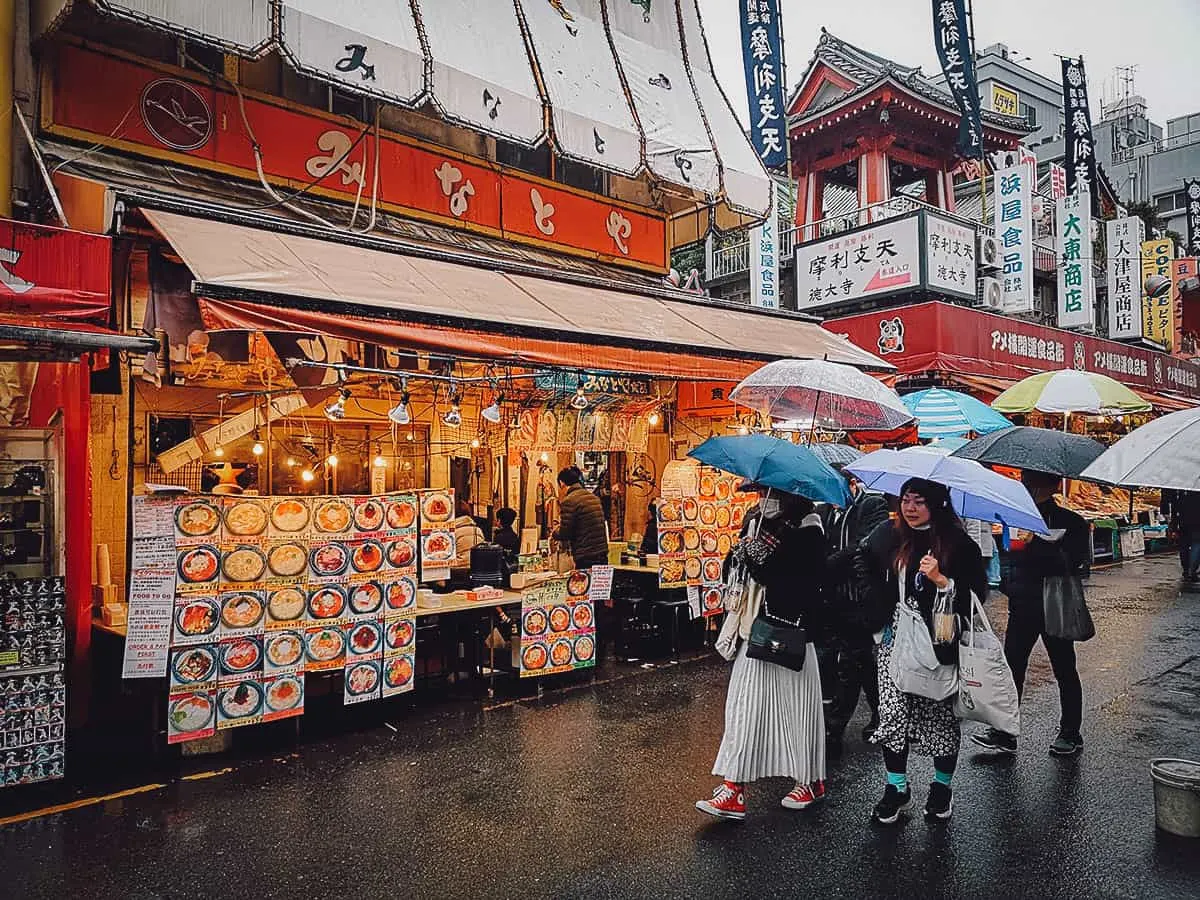
8. Sapporo Snow Festival in Hokkaido
Street food is a staple at Japanese festivals, and one of the most popular festivals you can attend is the Sapporo Snow Festival in Hokkaido. It’s an annual week-long festival in Sapporo featuring large snow and ice sculptures and a smorgasbord of Japanese street food.
Hokkaido is home to some of the best dairy and seafood in Japan – including some of the most enviable crabs – so you can expect a very high level of street food at the festival.
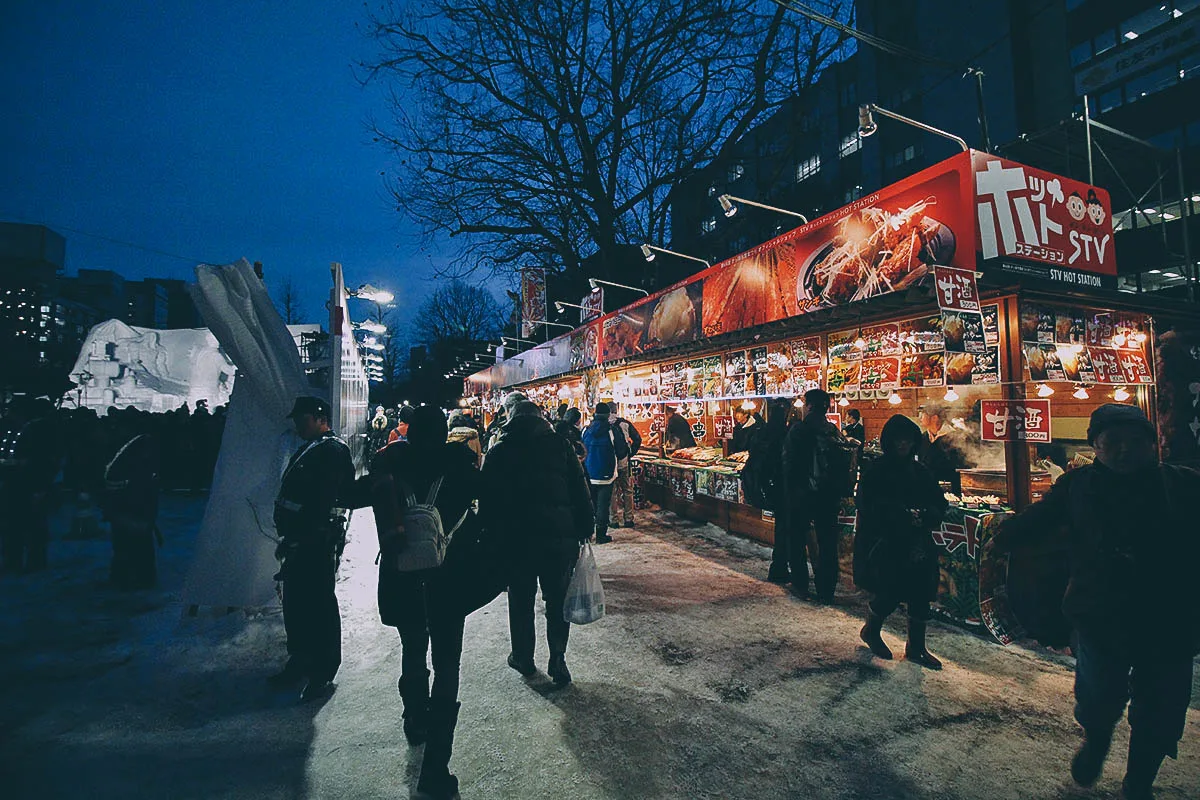
JAPANESE STREET FOOD TOURS
I love experiencing Japanese street food on my own but if you’re pressed for time, then you may want to go on a food tour. A knowledgeable local will take you to the city’s best spots and explain every street food dish to you in more detail. Simply put, when it comes to Japanese street food, no one knows better than a local.
Check out Get Your Guide and byFood for a list of food tours in Japan. Both are reputable companies that offer a good selection of street food tours, restaurant tours, and izakaya bar hopping tours in different cities throughout the country.
FINAL THOUGHTS ON JAPANESE STREET FOOD
Street food culture may not be as pronounced or as embraced in Japan as it is in other Asian countries, but as you can see from this list, there are quite a few street food dishes to look forward to on your next trip to Japan.
For me, Fukuoka’s yatai stalls offer the truest Japanese street food experience while festivals – if you can properly time your trip – offer the most enjoyable and relaxed environment. Eating while walking may be frowned upon in many parts of Japan but you don’t have to worry about any of that at Japanese festivals. Personally, committing a cultural faux pas is the last thing I want to worry about when eating street food in Japan.
In any case, I hope you enjoyed reading this article on the best street food dishes in Japan. If you have any suggestions on obscure regional Japanese street foods that we can add to this list, then please let us know in the comments below.
Thanks for reading and have an amazing time eating all the oishi street food in Japan!
Disclosure
Some of the links in this Japanese street food guide are affiliate links. We’ll get a small commission if you make a purchase at no additional cost to you. We only recommend products and services that we use ourselves and firmly believe in. We really appreciate your support as it helps us make more of these free travel guides. Thank you!


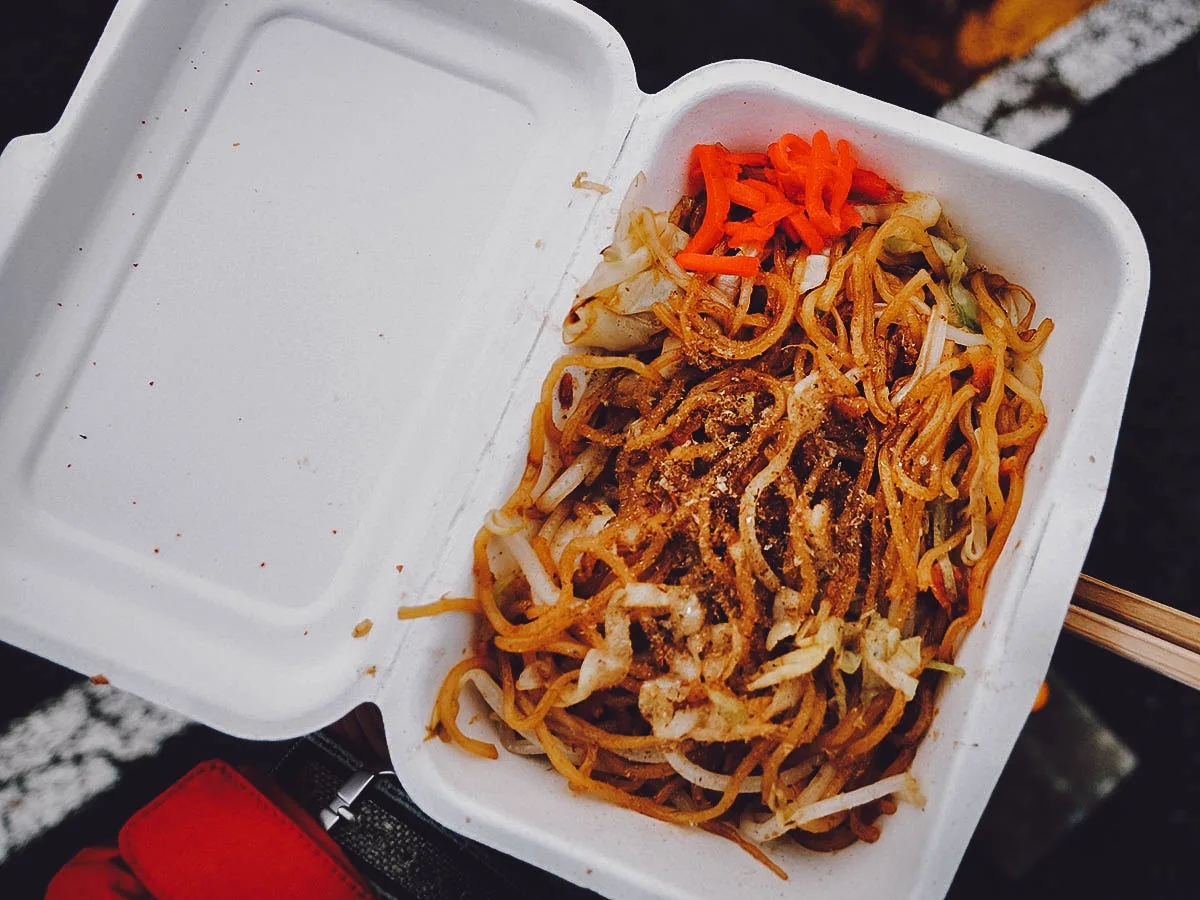
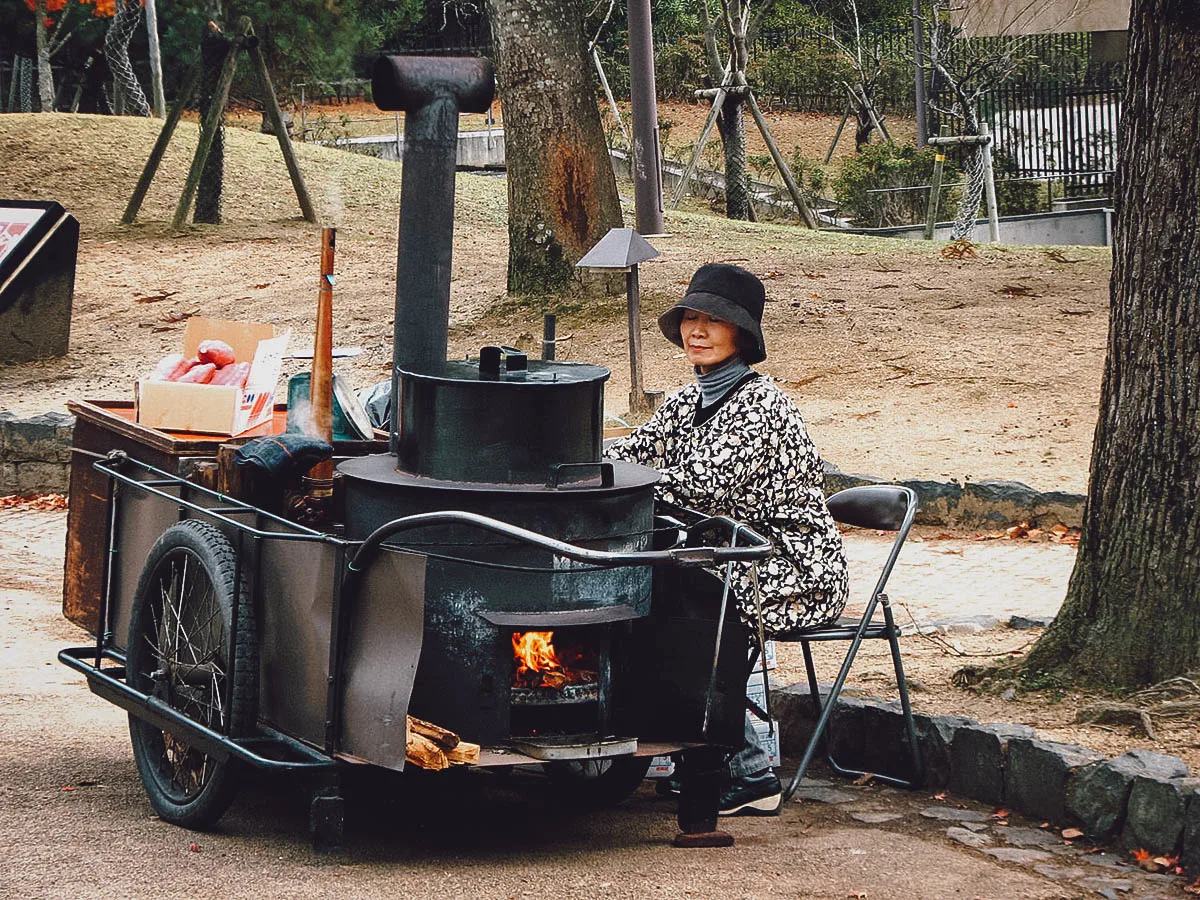
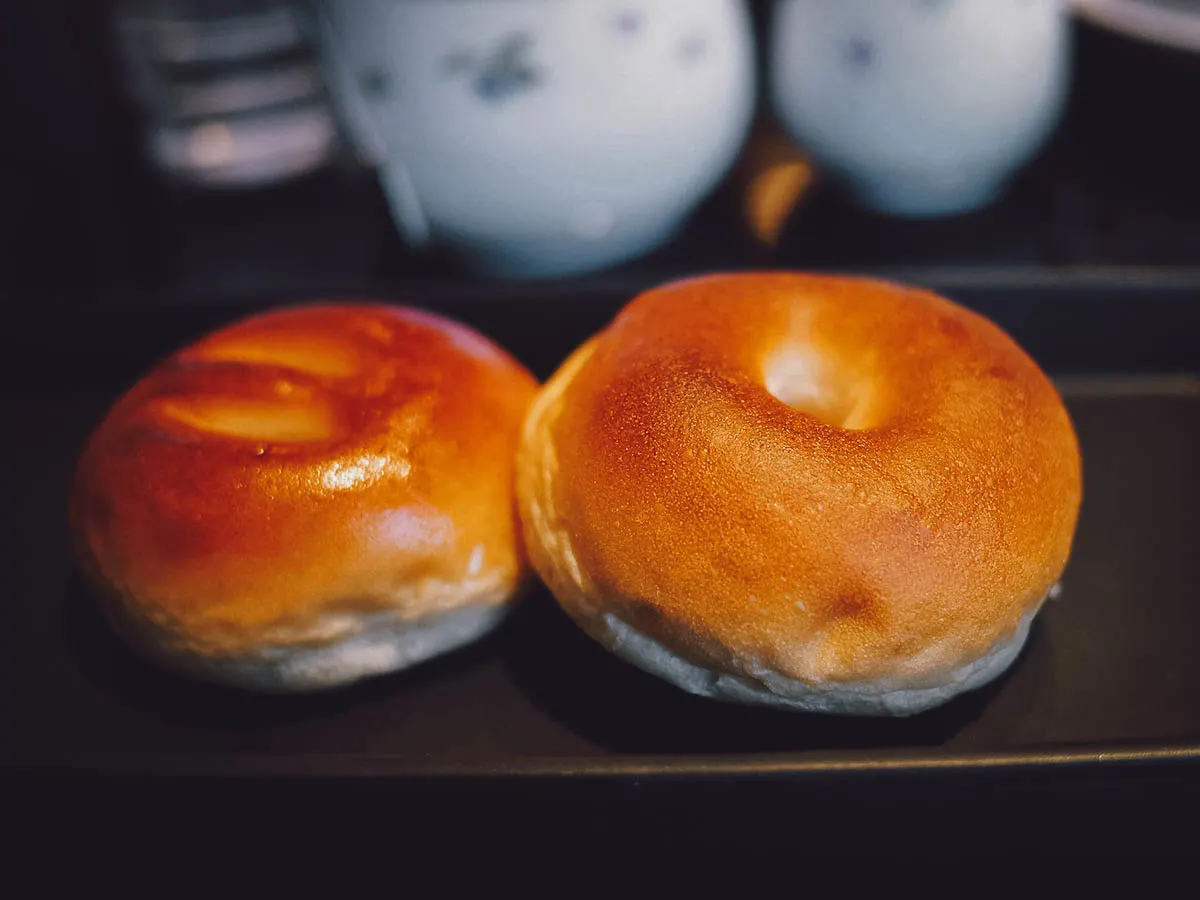
Ooma
Sunday 19th of March 2023
Thank you so much for a detailed write up on street foods and etiquette in Japan. Will be very helpful when we visit Japan :-)
JB & Renée
Wednesday 29th of March 2023
Happy you found it useful Ooma!
Martin
Thursday 11th of February 2021
Fascinating and awesome article. When I visited Japan, I had no idea about eating and walking is generally frowned upon and only learned afterwards. Thinking frantically back to remember if I did that or not. I think I haven't because most of the time I greedily devour whatever it is that I've brought right away!
I've eaten a few of them from this list but there are quite a few that I don't know. Lots of new ones to try out! I'm really curious about how the baby octopus on a stick tastes! Takoyaki is my absolute favourite and can eat it forever and never grow bored of it. I had the Korokke there in a suburb of Tokyo from a random place. I had no idea what it was actually but still dream of it to this day...
Japanese street food may not be as entrenched in the culture as some other places but it's no less delicious!
JB & Renée
Friday 12th of February 2021
Hi Martin, I think this is what makes Japanese culture so fascinating – all the quirks and rules that we as foreigners aren't accustomed to. It's very different in that regard from any other country on earth. The eccentricities, the traditions, the mindfulness, the efficiency, the food - Japan never gets tiring!